Self Watering Plant Pots
How Do Self Watering Planter Pots Work
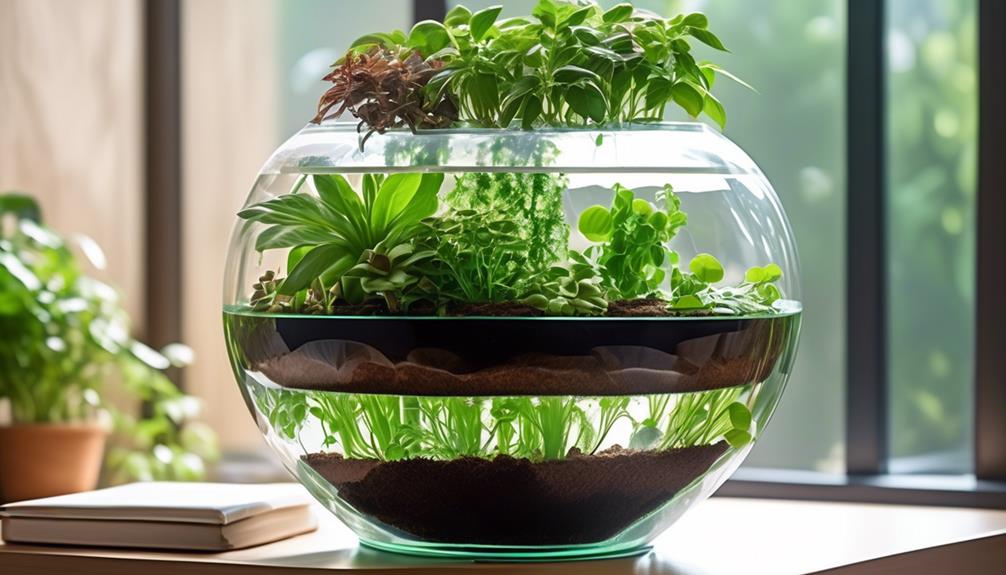
We’ve all encountered this challenging scenario: aiming to provide the perfect measure of water to our plants, ensuring we neither drench them nor leave them thirsty. What’s the answer? Self-watering planter pots, a modern solution to this age-old problem.
But how exactly do they work? The answer lies in the clever design and innovative technology behind these pots, which I'll be exploring in detail.
Stay tuned to uncover the science and benefits behind self-watering planter pots, and learn how they could revolutionize the way you care for your plants.
Key Takeaways
- Self-watering pots automatically supply water to plants as needed.
- The wicking system's efficiency depends on the material used for the wick.
- The water reservoir holds water that's drawn up into the soil as needed.
- Self-watering pots optimize water usage and promote optimal soil moisture levels.
The Basics of Self-Watering Pots
Self-watering pots automatically supply water to plants as needed, making them a convenient and efficient option for maintaining healthy vegetation.
Understanding the basics of self-watering pots is essential for optimizing plant growth. These pots have a reservoir that holds water, and the soil sits on top of a perforated platform separating it from the water below. Through capillary action, the soil draws up water from the reservoir, ensuring consistent soil moisture. This mechanism helps in regulating the watering frequency, as the plant draws water from the reservoir only when needed.
The design prevents overwatering, which can lead to root rot, and underwatering, which can cause plant stress. By maintaining optimal soil moisture, self-watering pots promote healthier root systems and overall plant growth.
It's important to monitor the water level in the reservoir to ensure a steady supply for the plants. Understanding the dynamics of water movement within the self-watering pot is crucial for effectively utilizing this innovative system to support thriving plant life.
Understanding the Wicking System
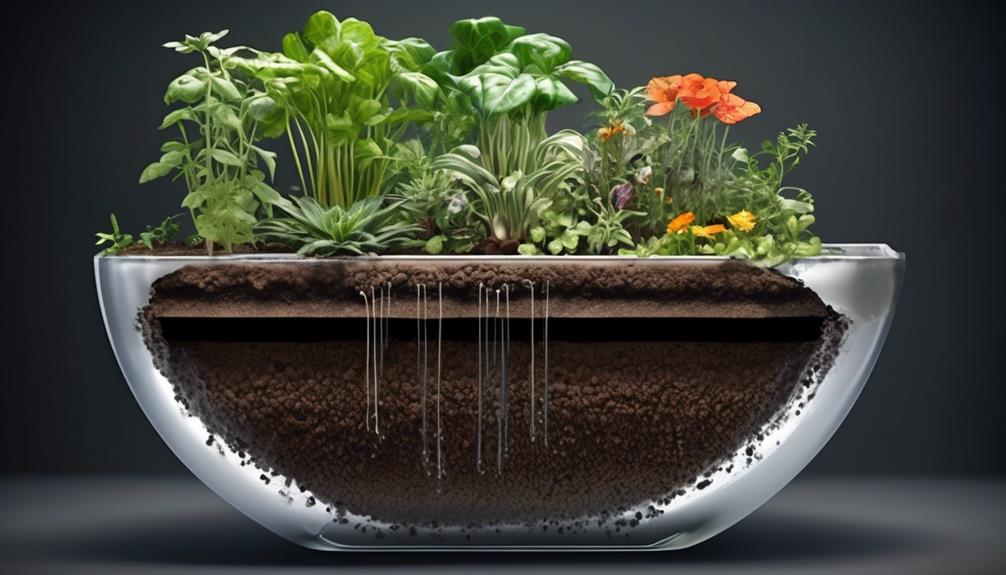
Understanding the wicking system involves comprehending the process by which water moves from the reservoir to the soil, ensuring consistent moisture for plant growth. The wicking process is facilitated by capillary action, where water is drawn upward through the soil and into the root zone. This mechanism relies on the cohesive and adhesive properties of water, allowing it to move against gravity.
The following points provide a deeper understanding of the wicking system:
- Capillary Action: This fundamental concept involves the movement of water within the tiny spaces of a porous material, such as soil or a wick. Capillary action is the driving force behind the wicking process, enabling water to be transported from the reservoir to the soil.
- Water Absorption: The wicking system's efficiency depends on the material used for the wick, as it determines the rate of water absorption. Materials with high capillary action, like cotton or felt, are often employed to ensure optimal moisture distribution.
- Moisture Distribution: Once the water is drawn up through the wick, it disperses into the surrounding soil, maintaining a consistent level of moisture essential for healthy plant growth.
Mastering the wicking system is crucial for maximizing the benefits of self-watering planter pots, ensuring that plants receive the water they need for sustained health and vitality.
Exploring the Water Reservoir
Examining the water reservoir reveals its critical role in providing a consistent water supply to the soil, essential for sustaining plant health and growth. The reservoir, typically located at the bottom of the planter, holds water that's drawn up into the soil as needed. This self-watering system regulates the watering frequency, preventing both overwatering and underwatering, and maintaining optimal moisture levels for the plants.
Reservoir maintenance is crucial for the proper functioning of the self-watering planter. Regularly checking the reservoir for debris, such as dirt or roots, is essential to ensure unimpeded water flow. Additionally, cleaning the reservoir periodically prevents the buildup of algae and mold, which can negatively impact the water quality and, subsequently, the plant's health.
Understanding the watering frequency is vital for the effective utilization of the water reservoir. Factors such as plant type, environmental conditions, and the size of the planter directly influence the rate at which water is drawn from the reservoir. Monitoring the soil moisture and adjusting the reservoir's water level accordingly is key to providing the right amount of water for optimal plant growth.
Benefits of Self-Watering Pots
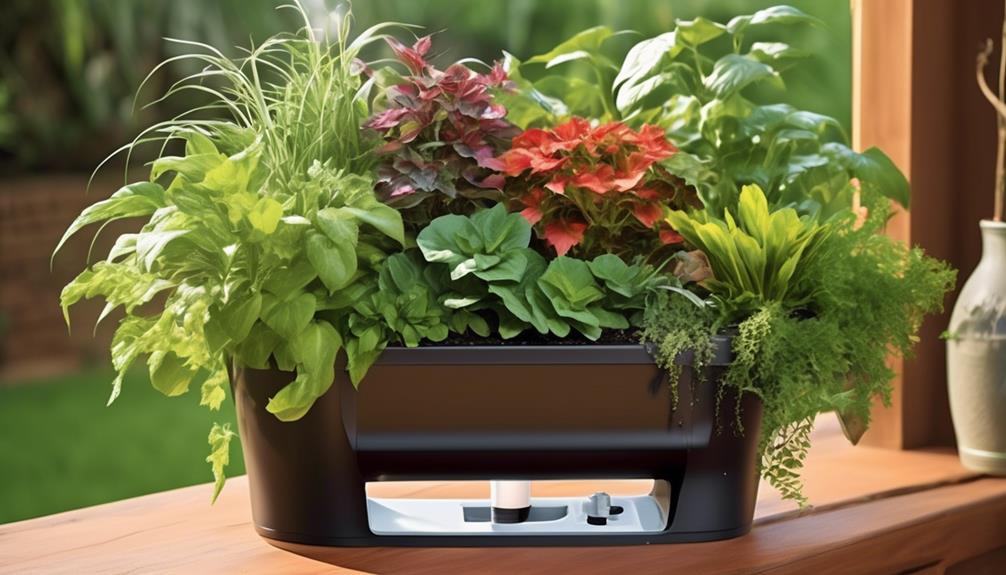
The advantages of utilizing self-watering pots extend beyond simply providing a consistent water supply to the plants. There are several benefits that contribute to the overall health and growth of the plants:
- Watering Efficiency
- Self-watering pots optimize water usage by delivering water directly to the plant's roots as needed, reducing water wastage through evaporation or runoff.
- The water reservoir in self-watering pots prevents overwatering, a common issue in traditional pots, by allowing the plant to draw in water as required, promoting optimal soil moisture levels.
- Plant Health
- Consistent moisture levels provided by self-watering pots support robust root development, which is crucial for overall plant health and growth.
- By preventing water stress, self-watering pots help plants to thrive, leading to healthier foliage, vibrant blooms, and better fruit production.
Choosing the Right Soil
When selecting soil for self-watering pots, we prioritize a composition that complements the watering efficiency of the pots, supporting optimal moisture levels and root development for the plants. The ideal soil composition for self-watering pots should have a balanced mix of organic matter, such as peat moss or coconut coir, to improve water retention and aeration. These components help maintain consistent moisture levels while ensuring that the roots have access to oxygen.
Additionally, adding perlite or vermiculite to the soil mix can further enhance water retention and drainage, preventing waterlogged conditions that can lead to root rot. It's important to avoid using dense, compacted soils that hinder water movement and root growth, as these can impede the self-watering system's effectiveness.
Furthermore, incorporating a slow-release fertilizer into the soil mix can provide essential nutrients to the plants over an extended period. By carefully considering the soil composition, water retention, and nutrient availability, we can maximize the benefits of self-watering pots and create an optimal environment for plant growth.
Filling and Maintaining the Reservoir
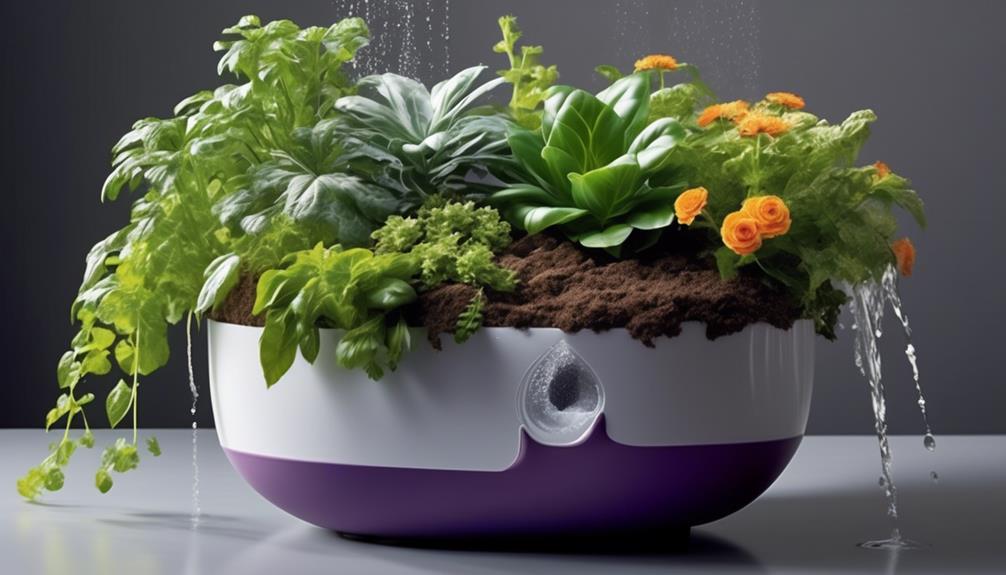
We will now discuss the process of filling and maintaining the reservoir in self-watering planter pots.
- Filling Techniques
- To fill the reservoir, pour water through the designated fill spout until the indicator shows that it's full. This prevents overfilling and ensures optimal water distribution.
- When using the wick system, gently pour water into the soil until the reservoir is full. The wick will absorb the water and distribute it to the plant's roots as needed.
- Water Absorption
- The soil and wick, if present, absorb water from the reservoir through capillary action, ensuring the plant has consistent access to moisture.
- Some self-watering pots have a water gauge to visually indicate the water level in the reservoir, allowing users to monitor and adjust water levels as needed.
- Reservoir Maintenance
- Regularly check the water level in the reservoir to ensure it doesn't run dry, especially during hot weather or when the plant's water needs increase.
- Clean the reservoir periodically to prevent mineral buildup, algae growth, or the development of unpleasant odors that may affect the plant's health.
- Regular maintenance ensures proper water distribution and a healthy growing environment for your plant.
Monitoring Water Levels
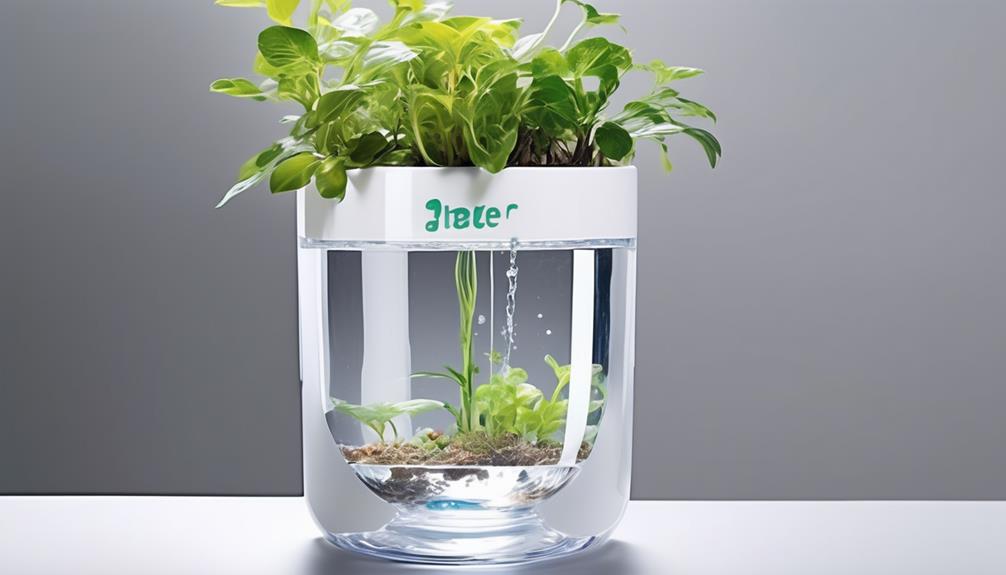
Monitoring water levels in self-watering planter pots involves regularly checking the reservoir to ensure adequate moisture for the plant's needs. It is essential to maintain the optimal moisture levels to support plant growth and prevent overwatering or underwatering. To achieve this, understanding the watering frequency and the correlation between the water reservoir and the plant's moisture requirements is crucial. Here is a table summarizing the key points to consider when monitoring water levels in self-watering planter pots:
| Aspect | Considerations | Actions |
|---|---|---|
| Watering frequency | Check the water levels every few days | Adjust the frequency based on plant needs |
| Optimal moisture levels | Monitor the soil moisture using a probe | Refill the reservoir when needed |
Customizing for Different Plants
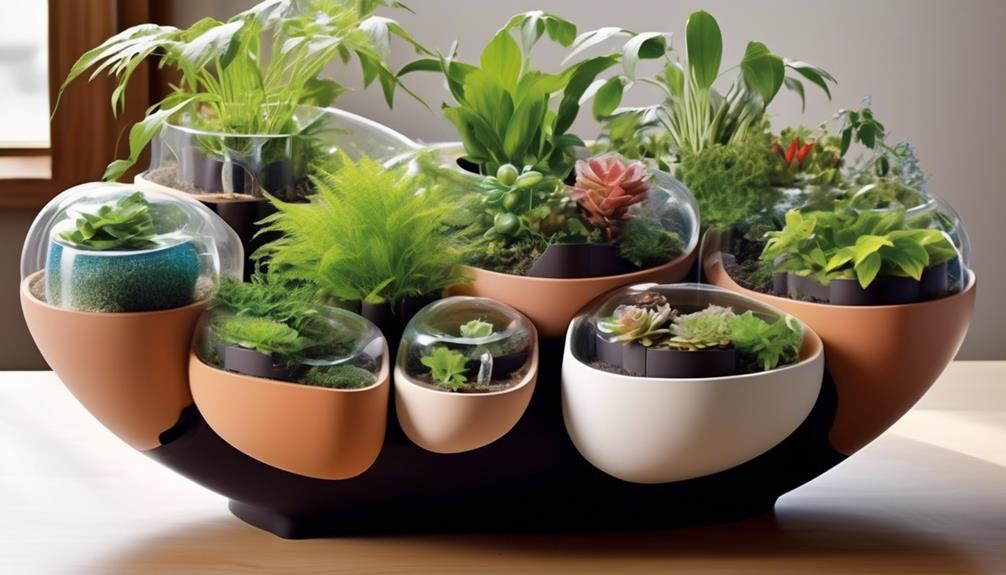
When customizing self-watering planter pots for different plants, it's essential to consider the specific water requirements of each plant. Adjusting the watering mechanisms based on the plant's needs can optimize growth and prevent overwatering or underwatering.
Understanding plant-specific water levels will allow for precise customization of the self-watering system, promoting healthy and thriving plant growth.
Plant-Specific Water Levels
Different plants have varying water requirements, and it's essential to adjust the watering levels to meet the specific needs of each plant species. When customizing watering solutions for different plants, it's crucial to consider the optimal hydration levels for each specific plant type.
This can be achieved through the following:
- Understanding Plant Specific Needs:
- Research the specific hydration requirements of each plant species to determine the ideal watering levels.
- Consider factors such as the plant's native environment, growth stage, and water retention capacity of the soil.
- Implementing Irrigation Systems:
- Utilize self-watering pots with adjustable water reservoirs to tailor the watering frequency and volume to the plant's specific needs.
- Adapting Watering Solutions:
- Adjust the watering schedule and methods based on the plant's individual requirements to ensure optimal hydration levels are consistently maintained.
Adjusting Watering Mechanisms
To tailor the watering frequency and volume to the specific needs of different plant species, implementing irrigation systems such as self-watering pots with adjustable water reservoirs is essential.
Adjusting the watering mechanism involves optimizing moisture levels and controlling the water flow to meet the precise requirements of various plants. For plants that prefer drier conditions, the flow rate can be reduced to limit the water supply, whereas for moisture-loving plants, the flow can be increased to ensure adequate hydration.
Comparing Traditional Watering Methods

By examining the effectiveness and efficiency of traditional watering methods, we can better understand their impact on plant growth and overall water consumption.
- Watering Frequency
Traditional watering methods often require frequent watering, as much as once a day, to maintain optimal soil moisture levels. The frequency of watering is influenced by various factors such as plant type, soil composition, and environmental conditions. Inconsistent watering frequency can lead to fluctuations in soil moisture, affecting plant health and growth.
- Soil Moisture
Traditional watering methods may result in uneven soil moisture distribution, with surface soil drying out quickly while lower layers remain moist. The manual watering process can lead to overwatering or underwatering, impacting the overall health and development of plants. Inadequate soil moisture management can also lead to nutrient leaching and root damage.
Extending Watering Intervals

Extending the interval between watering sessions can be achieved through the implementation of self-watering planter pots. These pots utilize a reservoir system to maintain consistent soil moisture levels. By utilizing capillary action, the soil draws water from the reservoir as needed, creating a self-sustaining cycle.
Maximizing efficiency is achieved through the optimization of the reservoir size, pot size, and plant type. This ensures that the water supply matches the specific needs of the plant. This precise control over water delivery reduces water consumption by preventing overwatering and minimizing evaporation.
Additionally, the use of soil moisture sensors can further enhance efficiency. These sensors provide real-time feedback on the moisture levels, allowing for adjustments to be made accordingly.
The design of the pot also plays a crucial role in extending watering intervals. It prevents waterlogging and ensures adequate aeration to the roots.
Addressing Common Concerns

We have observed that the watering mechanism in self-watering planter pots is a common concern for many plant enthusiasts.
To address this, we've developed a system that allows for the regulation of water flow, ensuring optimal moisture levels for the plants.
Additionally, our design prevents overwatering by incorporating a reservoir that collects excess water, thus protecting the root system from potential damage.
Watering Mechanism
The self-watering planter pots utilize a capillary action system to efficiently and effectively deliver water to the plant's roots. This mechanism ensures that the plant receives water as needed, addressing concerns related to watering frequency and evaporation prevention.
- Watering Frequency: The capillary action allows the plant to draw water from the reservoir as needed, ensuring a consistent supply without overwatering. This helps to maintain optimal soil moisture levels and prevents under or overwatering, addressing concerns about the frequency of watering.
- Evaporation Prevention: By utilizing a reservoir system, the self-watering planter pots minimize water exposure to the surrounding environment, reducing evaporation. This helps to conserve water and ensures that the plant receives a consistent water supply, addressing concerns about water loss due to evaporation.
- Even Water Distribution: The capillary wick or similar system ensures that water is evenly distributed throughout the soil, providing consistent moisture levels for the plant's roots.
Preventing Overwatering
To prevent overwatering, the self-watering planter pots employ a capillary action system that allows the plant to draw water from the reservoir only as needed, ensuring optimal soil moisture levels and avoiding waterlogging. This capillary action is facilitated by the use of a wicking mechanism, such as a string or fabric, which extends from the reservoir into the soil.
When the soil becomes dry, it creates a negative pressure, causing water to be wicked up from the reservoir into the soil, maintaining a consistent level of moisture. Additionally, proper drainage techniques, such as having drainage holes at the bottom of the planter, ensure that excess water can escape, preventing water from accumulating and causing root rot.
Tips for Successful Plant Care

Regularly monitor the moisture levels in the soil to ensure optimal hydration for your plants. This is crucial for successful plant care.
Here are some key tips for maintaining healthy plants in self-watering planter pots:
- Plant Placement and Watering:
- Ensure proper plant placement within the planter to optimize water distribution.
- Consider the specific water needs of each plant species and adjust the watering frequency accordingly.
- Be mindful of the plant's growth stage, as it can affect its water requirements.
- Soil Moisture and Sunlight Exposure:
- Use a soil moisture meter to accurately gauge the moisture levels in the soil.
- Adjust the planter's sunlight exposure based on the plant's preferences and requirements.
- Monitor the surrounding environmental conditions to maintain an ideal microclimate for the plants.
- Nutrient Management and Pruning:
- Consider the nutrient requirements of your plants and supplement the soil as needed.
- Regularly inspect and prune the plants to promote healthy growth and prevent overgrowth.
Frequently Asked Questions
Are Self-Watering Pots Suitable for All Types of Plants?
Self-watering pots are suitable for a variety of plants, but plant compatibility is key. Different plants have varying water needs, so it's essential to match them with the right self-watering system.
Understanding the watering frequency for each plant is crucial. Some plants, like succulents, require less water and may not thrive in self-watering pots designed for high water retention.
It's important to research the specific needs of your plants before choosing self-watering pots.
Can Self-Watering Pots Be Used Outdoors as Well as Indoors?
Yes, self-watering pots can be used outdoors as well as indoors. Outdoor usage is possible due to their long-term durability. The design allows for consistent moisture levels, reducing the frequency of watering.
The reservoir system prevents overwatering, making them suitable for a wide range of plants. The pots' material and construction ensure they can withstand outdoor conditions, making them a reliable choice for outdoor gardening.
How Often Do I Need to Refill the Water Reservoir in a Self-Watering Pot?
We typically refill the water reservoir in our self-watering pot every 1-2 weeks, depending on the plant's hydration needs and the reservoir size.
Monitoring soil moisture is essential to determine the watering frequency.
The reservoir size directly impacts the duration between refills.
It's crucial to maintain an adequate water level to ensure consistent and optimal plant hydration.
Regularly checking the reservoir and soil moisture is key to successful self-watering pot maintenance.
Are There Any Specific Maintenance Requirements for Self-Watering Pots?
We understand the concern over maintenance, but self-watering pots are designed to minimize upkeep. Regular cleaning ensures optimal water flow and prevents mold growth. Use a mild soap solution to clean the reservoir and a bleach solution for stubborn stains.
Fertilizer requirements are reduced due to the consistent moisture levels, but it's still essential to periodically replenish the soil with nutrients. This simple cleaning process and minimal fertilizer needs make self-watering pots low-maintenance options.
Can Self-Watering Pots Help Prevent Overwatering of Plants?
Self-watering pots can be beneficial in preventing overwatering by providing a reservoir for plants to draw water from as needed. This can help maintain optimal soil moisture levels and reduce the risk of root rot. However, there are some limitations to consider, such as the potential for the reservoir to become stagnant and the need to monitor water levels regularly.
Understanding the effectiveness and drawbacks of self-watering pots is crucial for successful plant care.
What are the Benefits of Using Self-Watering Planter Pots?
Self-watering pots explanation: Self-watering planter pots offer several benefits, such as reducing the time and effort needed for plant care, preventing overwatering, and ensuring consistent moisture levels for healthy plant growth. These pots are ideal for busy individuals or frequent travelers who want to maintain a thriving indoor or outdoor garden with minimal maintenance.
Conclusion
In conclusion, self-watering pots offer a convenient and efficient way to keep your plants hydrated. With a wicking system and water reservoir, these pots provide a consistent water supply to the roots, reducing the frequency of manual watering.
Like a well-oiled machine, the self-watering pot ensures that your plants receive the moisture they need to thrive, making it a valuable tool for any gardener.
So, give it a try and watch your plants flourish with minimal effort.
With a green thumb and a keen eye for detail, Kayla leads our content with expertise and enthusiasm. Her dedication to spreading the joy of home gardening is reflected in every piece of advice and tip shared. She ensures that our community receives the most reliable and practical gardening insights.
Self Watering Plant Pots
Do Self Watering Pots Cause Root Rot
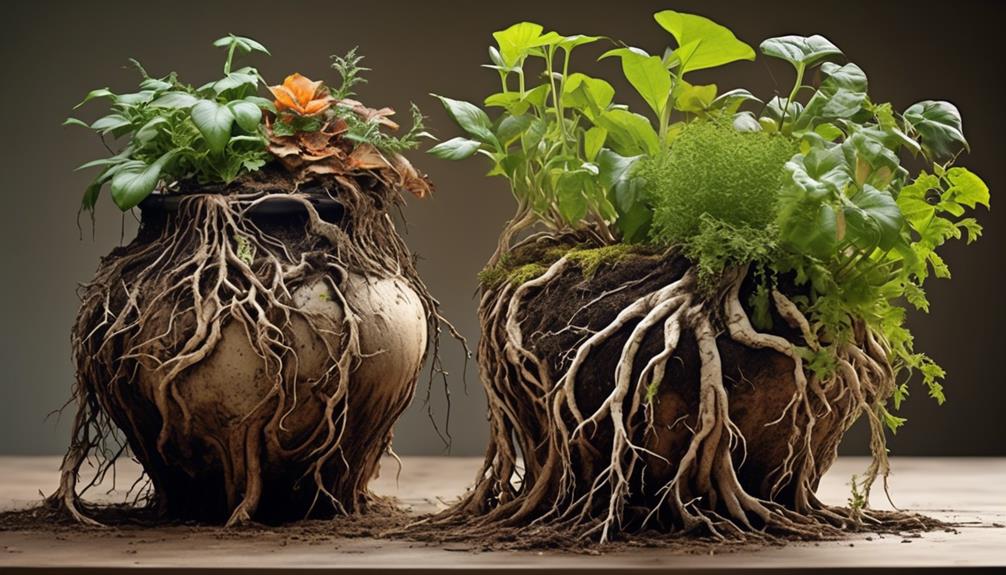
Ever wondered if self-watering pots could cause root rot? For those passionate about plants and committed to gardening, we’ve come across a range of opinions on this matter.
Some swear by the convenience of self-watering pots, while others warn of the potential dangers they pose to plant roots. But what's the truth behind this debate?
Is it possible that a self-watering pot, designed to provide just the right amount of moisture, could actually be detrimental to the health of our plants?
Let's explore the science behind it and uncover the facts that will help us make informed decisions about our gardening practices.
Key Takeaways
- Self-watering pots can contribute to the development of root rot due to poor drainage, waterlogged soil, and overwatering.
- Signs of root rot include wilting, yellowing or browning of leaves, stunted growth, and a foul odor from the soil.
- To prevent root rot in self-watering pots, it is important to implement effective drainage systems, monitor watering frequency, and choose a well-draining potting mix.
- Selecting plants with similar watering needs and shallow root systems can also help prevent root rot in self-watering pots.
Understanding Self-Watering Pot Functionality
We've observed that self-watering pots function by providing a reservoir of water that's absorbed by the plant as needed, preventing overwatering and promoting healthy root growth. Understanding pot design is crucial in grasping how self-watering pots operate.
These pots typically consist of an inner basket or pot that holds the plant and soil, and an outer reservoir that stores the water. The two parts are connected through a wicking system, which allows water distribution from the reservoir to the soil. This design ensures that the plant has access to water whenever it needs it, promoting optimal growth conditions.
Watering frequency is a key aspect of self-watering pots. The reservoir only needs to be refilled periodically, as the wicking system delivers water to the plant as required. This not only saves time and effort for the gardener but also provides a consistent moisture level for the plant, promoting healthy root development.
Moreover, the self-watering system encourages plant adaptation, as it mimics a natural watering process, prompting the plant to develop deeper and stronger roots in search of water. Understanding these functionalities is essential for harnessing the benefits of self-watering pots while avoiding potential issues such as root rot.
Signs and Symptoms of Root Rot
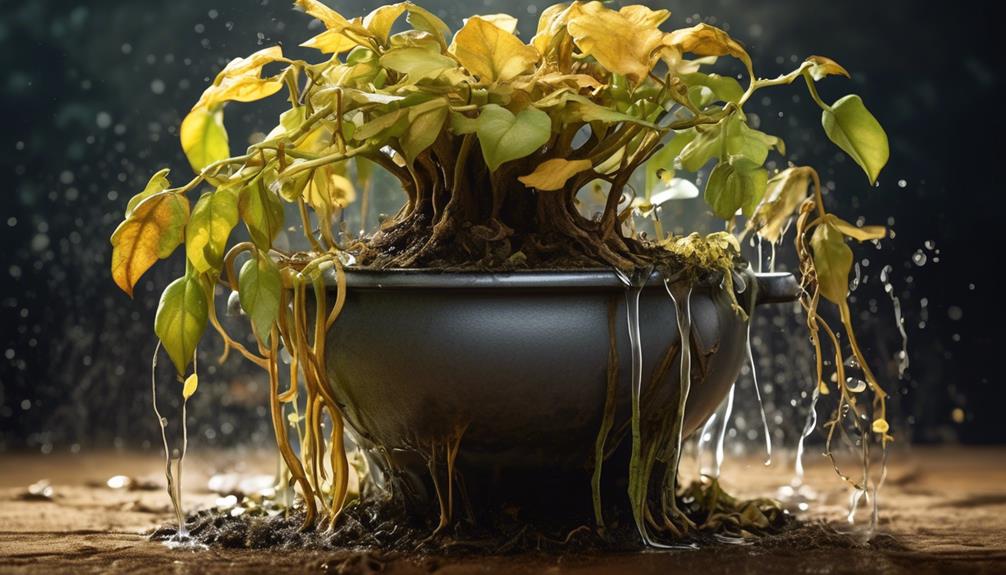
Understanding the functionality of self-watering pots is crucial for recognizing the signs and symptoms of root rot in plants. Root rot is a serious condition caused by excessive moisture around the roots, leading to their decay. It is essential to identify the early signs of root rot to prevent irreversible damage to your plants. Common signs of root rot include wilting, yellowing or browning of leaves, stunted growth, and a foul odor emanating from the soil. Additionally, when the plant is removed from the pot, healthy roots appear brown and firm, while rotted roots are slimy, dark, and easily detach from the plant.
To further illustrate the signs and symptoms of root rot, consider the following table:
| Signs of Root Rot | Symptoms of Root Rot |
|---|---|
| Wilting of leaves | Yellowing or browning of leaves |
| Stunted growth | Foul odor from soil |
| Dark, slimy roots | Easily detachable roots |
Preventive measures such as proper watering, well-draining soil, and adequate air circulation can help avoid root rot. In case of root rot, treatment options include removing affected roots, repotting in fresh soil, and adjusting the watering schedule to allow the roots to recover.
Factors Contributing to Root Rot in Self-Watering Pots
Root rot in self-watering pots can be influenced by several key factors, including the design of the pot and the frequency of watering. Factors such as poor drainage, waterlogged soil, and overwatering contribute to the development of root rot.
The design of the self-watering pot plays a crucial role in determining the likelihood of root rot. Pots with inadequate drainage or improper wicking systems can lead to water accumulation at the bottom, creating an environment conducive to root rot. Additionally, overwatering, a common practice with self-watering pots, can exacerbate the issue.
The symptoms of root rot, including yellowing leaves, stunted growth, and a foul odor, can be exacerbated by these factors. Understanding the impact of these factors is essential for preventing root rot in self-watering pots.
Prevention and Management Techniques
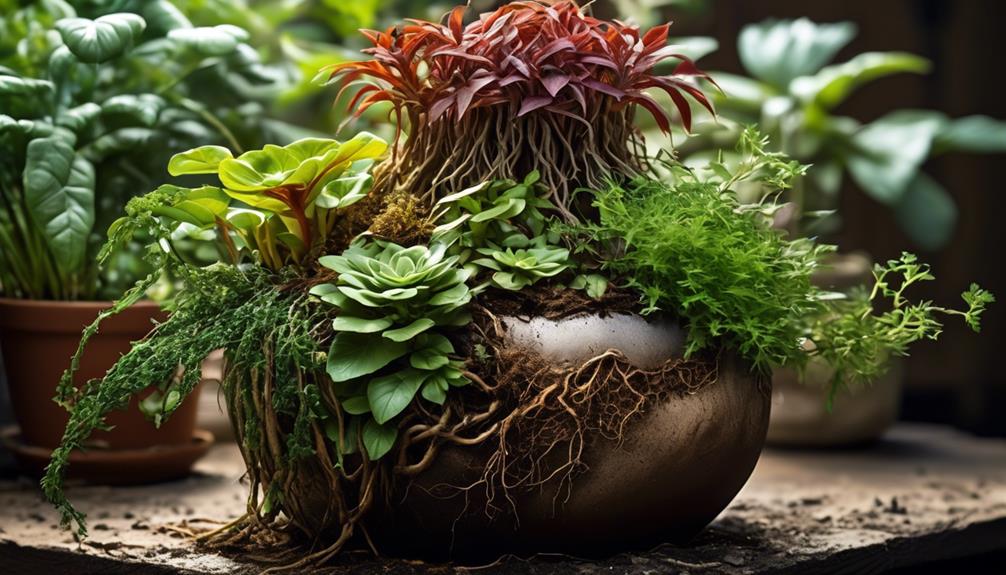
To prevent and manage root rot in self-watering pots, it is important to implement effective drainage systems and carefully monitor the watering frequency. Proper drainage is essential to prevent water from accumulating at the bottom of the pot, creating an environment conducive to root rot. Additionally, monitoring the watering frequency is crucial, as overwatering is a common cause of root rot in self-watering pots.
| Key Techniques for Prevention and Management | ||
|---|---|---|
| Effective Drainage Systems | Monitoring Watering Frequency | Choosing Suitable Potting Mix |
| Ensure pots have drainage holes to allow excess water to escape. | Regularly check the moisture level in the soil and adjust watering accordingly. | Select a well-draining potting mix to facilitate proper water distribution. |
Choosing the Right Plants for Self-Watering Pots
When selecting plants for self-watering pots, we need to consider their specific water requirements, the moisture levels they prefer in the soil, and the size of their root systems. Understanding the water needs of the plants is crucial to ensure they thrive in a self-watering pot environment.
Plant Water Requirements
Selecting appropriate plant species is crucial when considering the water requirements for self-watering pots. It's important to match the plant's water needs with the capabilities of the self-watering pot system to ensure optimal growth and health.
Here are some key considerations for choosing the right plants for self-watering pots:
- Watering Frequency: Select plants that have similar watering needs to avoid overwatering or underwatering.
- Plant Growth: Choose plants that are well-suited for container growth and won't outgrow the self-watering pot too quickly.
- Root Structure: Consider plants with shallow root systems to effectively utilize the self-watering feature.
- Climate Adaptability: Opt for plants that thrive in the specific environmental conditions provided by the self-watering pot's location.
Soil Moisture Levels
Considering soil moisture levels is essential when choosing the right plants for self-watering pots, as it directly impacts the successful utilization of the self-watering system. Proper soil moisture control is crucial for preventing both under and over-watering, which can affect plant health. To aid in plant selection, it's important to understand the watering frequency and moisture requirements of different plant species. Below is a table detailing the moisture preferences and watering frequency for common plant types suitable for self-watering pots:
| Plant Type | Soil Moisture Preference | Watering Frequency |
|---|---|---|
| Succulents | Low | Infrequent |
| Herbs | Moderate | Regular |
| Leafy Greens | High | Frequent |
| Flowering Plants | Variable | Variable |
Understanding the soil moisture needs of plants is crucial to maximize the effectiveness of self-watering pots and ensure the health and vitality of the chosen plant species.
Root System Size
Understanding the moisture preferences of different plant types is crucial when considering the root system size for selecting the right plants for self-watering pots. The size of a plant's root system is closely linked to its water requirements and its ability to utilize the available water. When choosing plants for self-watering pots, it's essential to consider the root system development and potting mix composition to ensure optimal growth and prevent issues such as root rot.
Factors to consider include:
- Root System Development: Some plants have extensive root systems, while others have more compact ones. Understanding the root development of the chosen plant is vital for selecting an appropriately sized self-watering pot.
- Potting Mix Composition: The composition of the potting mix directly impacts the root system's ability to access water and nutrients.
- Watering Frequency: Different root systems require different watering frequencies to thrive in self-watering pots.
- Plant Size: The size of the plant and its root system should match the size of the self-watering pot to avoid waterlogging or underwatering issues.
Best Practices for Using Self-Watering Pots
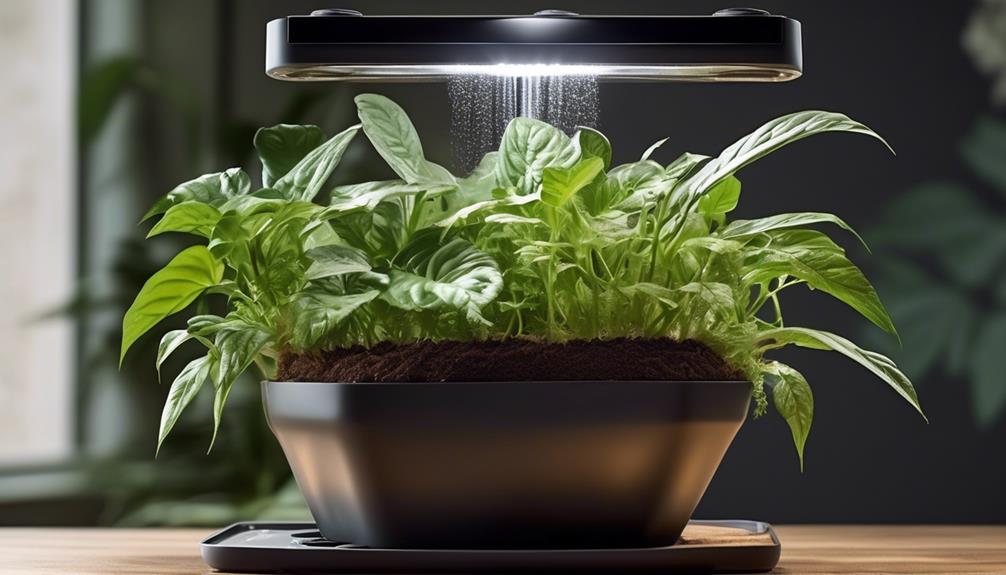
When using self-watering pots, it's crucial to implement proper watering techniques and choose the right soil for optimal plant health.
We'll explore the best practices for maintaining the right moisture levels and selecting soil that promotes healthy root development.
These key points will help ensure the success of your plants in self-watering pots.
Proper Watering Techniques
In self-watering pots, it's crucial to maintain a careful balance in the watering process to ensure optimal plant health and prevent the development of root rot. Proper drainage is essential to prevent waterlogging, while maintaining the right watering frequency is crucial for plant hydration.
Here are the best practices for watering in self-watering pots:
- Monitor Soil Moisture: Use a moisture meter or simply stick your finger into the soil to gauge moisture levels. This helps in determining when to water.
- Water Sparingly: Avoid overfilling the reservoir to prevent water accumulation at the bottom, which can lead to root rot.
- Adjust Based on Plant Needs: Different plants have varying water requirements, so adjust the watering frequency accordingly.
- Observe Plant Responses: Watch for signs of overwatering or underwatering, such as wilting or yellowing leaves, to adjust your watering routine.
Choosing the Right Soil
Selecting the appropriate soil is pivotal for achieving optimal plant growth and health in self-watering pots. The right soil composition ensures proper water retention and aeration, which are essential for preventing root rot and promoting root development. When choosing soil for self-watering pots, it's crucial to consider factors such as water retention capacity, nutrient content, and aeration properties. A well-balanced soil mix will support healthy root growth and prevent waterlogged conditions that can lead to root rot. Here's a comparison of different soil compositions commonly used in self-watering pots:
| Soil Type | Water Retention Capacity | Aeration Properties |
|---|---|---|
| Peat-based mix | High | Moderate |
| Coir-based mix | Moderate | High |
| Perlite mix | Low | High |
Understanding the water retention capacity and aeration properties of different soil compositions is essential for determining the appropriate watering frequency and ensuring optimal plant health in self-watering pots.
Frequently Asked Questions
Can Self-Watering Pots Be Used for All Types of Plants, or Are There Specific Ones That Are Better Suited for This Type of Pot?
We believe self-watering pots offer great flexibility and convenience for a variety of plants.
The best plants for self-watering pots include those that prefer consistently moist soil, such as ferns, peace lilies, and certain herbs.
Indoor and outdoor plants can thrive in self-watering pots, but it's important to consider the specific watering needs of each plant.
Understanding which plants are best suited for self-watering pots is crucial for their successful growth.
Are There Any Maintenance Tasks That Need to Be Performed Regularly to Prevent Root Rot in Self-Watering Pots?
Regular maintenance in self-watering pots is essential to prevent root rot. We recommend checking the watering schedule to ensure proper moisture levels. Using well-draining soil and incorporating prevention techniques like monitoring for signs of overwatering are crucial.
Additionally, for outdoor considerations, protect the pots from excessive rain to avoid waterlogged soil. These practices help maintain optimal growing conditions and prevent root rot in self-watering pots.
How Often Should the Water Reservoir in a Self-Watering Pot Be Refilled to Avoid Overwatering and Root Rot?
We refill the water reservoir of a self-watering pot based on the plant's needs, pot size, and environmental conditions.
Regularly monitoring the soil moisture and adjusting the refilling frequency helps prevent overwatering and root rot.
Choosing a well-draining potting mix and considering outdoor factors like temperature and sunlight also influences the refilling schedule.
These practices ensure optimal moisture levels, promoting healthy plant growth and preventing root rot in self-watering pots.
Are There Any Specific Soil Types or Potting Mixes That Are Recommended for Use in Self-Watering Pots to Prevent Root Rot?
When using self-watering pots, it's crucial to select the right soil type and potting mix to prevent root rot. Opt for well-draining soil with a balanced mix of organic matter and perlite. This encourages healthy root growth and prevents waterlogging.
Consider adding a layer of coarse material at the bottom to improve drainage. By choosing the appropriate soil and mix, you can effectively maintain the ideal moisture levels and avoid root rot in self-watering pots.
Can Self-Watering Pots Be Used Outdoors, and if So, Are There Any Additional Considerations for Preventing Root Rot in an Outdoor Environment?
Yes, self-watering pots can be used outdoors. Preventing overwatering is crucial for outdoor plant care, especially with self-watering pots.
Outdoor watering techniques, such as adjusting the watering frequency based on weather conditions, are important.
Self-watering pots offer benefits like consistent moisture levels, but proper monitoring is key.
Choosing a well-draining soil mix and maintaining good airflow around the roots can help prevent root rot in an outdoor environment.
Do Self Watering Pots Increase the Risk of Root Rot?
Yes, self watering pots and plants can increase the risk of root rot if not used properly. Overwatering can lead to waterlogged soil and lack of oxygen in the roots, causing root rot. It’s important to monitor water levels and allow the soil to dry out between watering to prevent this issue.
Conclusion
In conclusion, self-watering pots can potentially cause root rot if not properly managed. However, with the right prevention and management techniques, such as proper plant selection and regular monitoring, the risk of root rot can be minimized.
It's important to understand the functionality of self-watering pots and to follow best practices for using them. With these measures in place, the benefits of self-watering pots far outweigh the risk, making them a valuable tool for plant care.
Self Watering Plant Pots
Transparent Self Watering Pot

Bringing a **new plant** into your cozy space fills you with excitement, hoping it’ll thrive! But here’s the hitch: figuring out just the right amount of water is like cracking a secret code.
Enter the transparent self-watering pot, a modern solution that takes the guesswork out of plant care.
But why stop there? As we explore the ins and outs of this innovative gardening tool, we'll uncover the science behind its self-watering system, discover how to choose the perfect plants for this setup, and even delve into the sustainable and eco-friendly features that make it a win-win for both plants and the planet.
Key Takeaways
- Clear view of water level for easy monitoring of plant's hydration needs
- Prevents overwatering or underwatering, which can cause plant stress and decline
- Simplifies maintenance by reducing frequency of watering
- Promotes healthier plant growth by maintaining consistent moisture levels
Benefits of Transparent Self Watering Pot
Transparent self-watering pots provide a clear view of the water level, allowing for easy monitoring of the plant's hydration needs. The benefits of using these pots are numerous.
The visibility of the water level inside the pot is crucial for effective plant care. This visibility enables us to maintain the optimal water level, preventing overwatering or underwatering, which are common causes of plant stress and decline. Additionally, the transparent design allows us to observe the condition of the water, ensuring it remains clean and free from impurities that could harm the plant's roots.
Furthermore, transparent self-watering pots simplify maintenance. By providing a clear view of the water level, these pots make it easy to gauge when it's time to refill the reservoir, reducing the frequency of watering and minimizing the risk of water-related issues. This not only saves time and effort but also promotes healthier plant growth by maintaining consistent moisture levels.
How the Self Watering System Works
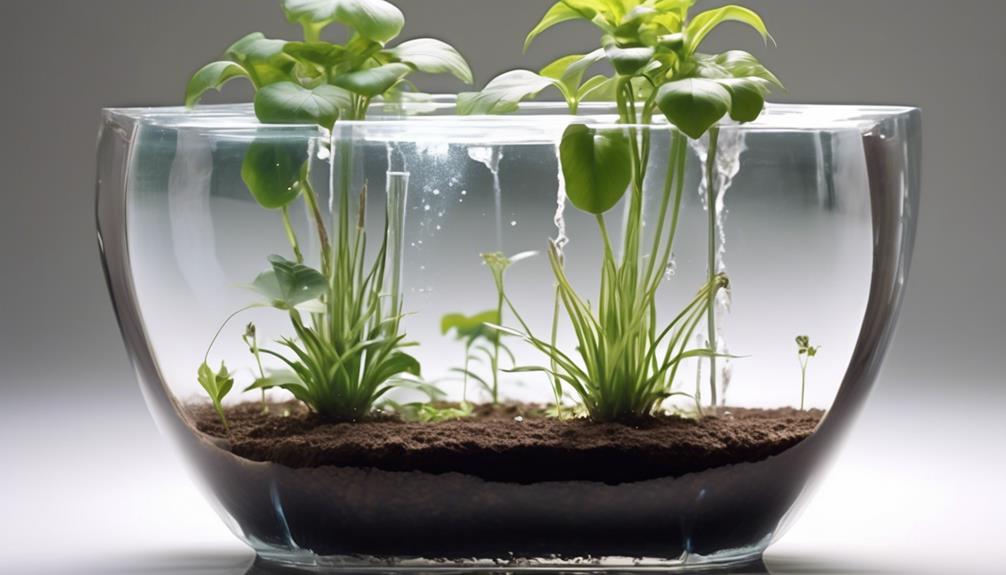
The visibility of the water level in the transparent self-watering pots allows for easy monitoring of the plant's hydration needs.
Understanding the mechanism behind how the self-watering system works is crucial for effective plant care.
Here's a breakdown of how the self-watering system operates:
- Watering Mechanism: The self-watering pot consists of a reservoir at the bottom, which is separated from the soil by a wick or a porous barrier. When the soil becomes dry, it draws water from the reservoir through capillary action, ensuring that the plant receives water as needed.
- Efficiency: By providing water directly to the roots as required, the self-watering system minimizes water wastage and ensures that the plant receives a consistent water supply, promoting healthy growth while reducing the frequency of manual watering.
- Evaporation Control: The design of the self-watering pot minimizes water loss through evaporation, as the reservoir is covered, reducing the frequency of refilling and maintenance required.
- Maintenance: The self-watering system simplifies plant care by extending the time between watering sessions, making it an efficient choice for individuals seeking low-maintenance plant care solutions.
Understanding how the self-watering system operates empowers plant enthusiasts to provide optimal care for their green companions.
Choosing the Right Plants for Self Watering Pots
When choosing plants for self-watering pots, it's important to consider the ideal plant types and their watering frequency.
Certain plants, such as succulents and cacti, are well-suited for these pots due to their low water requirements.
On the other hand, leafy greens and herbs may thrive in self-watering pots with more frequent watering needs.
Ideal Plant Types
Selecting suitable plant types for self-watering pots involves considering the specific water and light requirements of the plants. When choosing the right plants, it's important to consider whether they're ideal indoor plants or suitable for outdoor environments.
Here are some key factors to consider when selecting plant types for self-watering pots:
- Ideal indoor plants: Opt for low-maintenance plants such as snake plants, pothos, peace lilies, and spider plants, which thrive in low to moderate light conditions and require minimal watering.
- Outdoor plant options: Consider plants like succulents, herbs, and certain flowering varieties that can thrive in outdoor self-watering pots, as they typically require more sunlight and have different watering needs compared to indoor plants.
Watering Frequency
Considering the specific water and light requirements of potential plant options is essential when determining the suitable watering frequency for self-watering pots. Different plant species have varying water needs, and understanding these requirements is crucial for optimizing the self-watering benefits.
Some plants, such as succulents and cacti, thrive in drier conditions and may only require watering every 2-3 weeks. On the other hand, tropical plants like ferns and peace lilies prefer consistently moist soil and might need watering every 1-2 weeks.
It's important to monitor the moisture level of the soil and adjust the watering frequency accordingly. Self-watering pots offer advantages in maintaining consistent moisture levels, but it's still essential to consider the specific needs of the chosen plants to ensure they thrive.
Following these watering tips and frequency adjustments will help maintain optimal plant health.
Setting Up Your Transparent Self Watering Pot
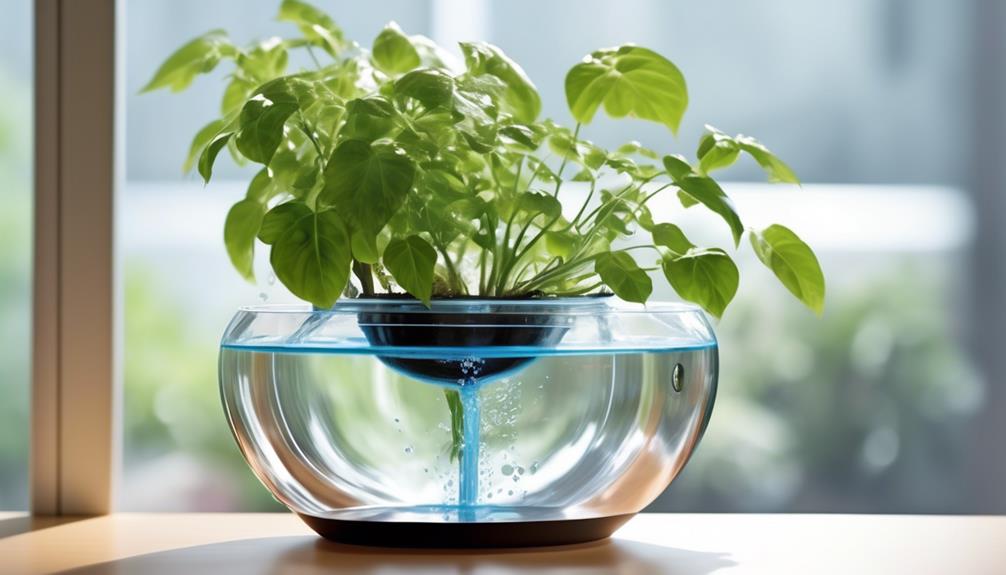
To prepare the transparent self-watering pot for use, follow these steps:
- Choose the Right Soil: Use a well-draining potting mix to promote healthy root growth and prevent waterlogging.
- Selecting the Plant: Choose a plant that's suitable for self-watering pots and fits the size of your transparent pot. Consider the plant's water requirements and growth habits.
- Planting Technique: After filling the bottom compartment with water, carefully plant your chosen greenery in the top reservoir, making sure to position the wick so that it reaches the water below.
- Watering Technique: Once the plant is in place, the self-watering system will automatically provide water to the plant as needed. Monitor the water level in the bottom compartment regularly and refill as necessary.
Monitoring Water Levels in the Pot
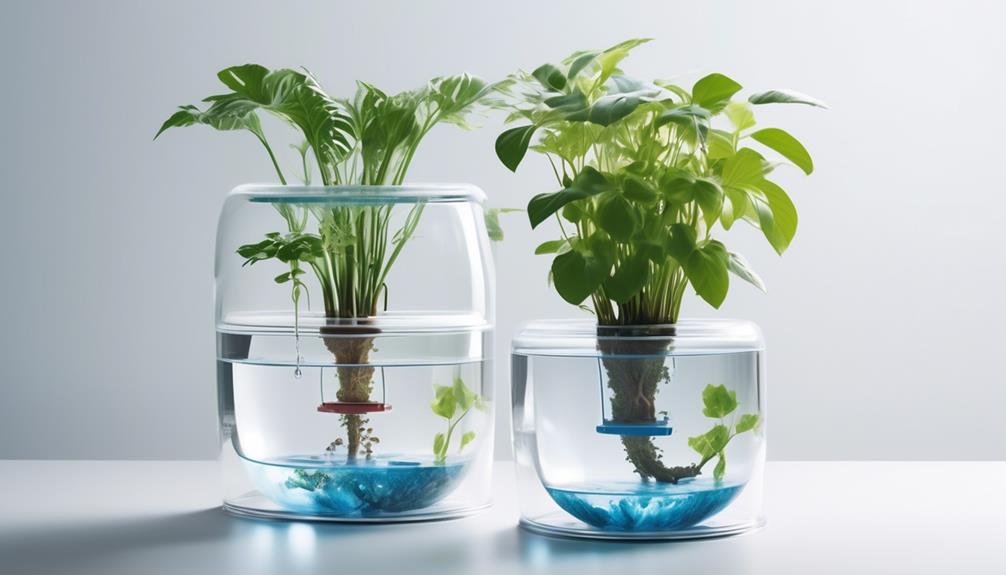
We need to discuss how to monitor water levels in the self-watering pot.
The visual water indicator allows us to easily see the water level without needing to open the pot.
This clear visibility ensures that we can maintain the optimal water level for our plants.
Visual Water Indicator
A clear, visible water indicator is essential for easily monitoring the water levels in the self-watering pot, ensuring efficient maintenance of plant hydration. Here are some key aspects to consider when evaluating the visual water indicator:
- Transparency: The water indicator should be transparent, allowing for clear visibility of the water level without the need to open or disturb the pot.
- Graduated Markings: Clear and accurate graduated markings on the indicator make it easier to assess the water level and fulfill maintenance requirements.
- Color Contrast: The indicator should feature contrasting colors to ensure visibility and easy distinction of the water level, even from a distance.
- Low Maintenance: The visual water indicator should be easy to clean and maintain, ensuring its functionality and longevity in monitoring plant health.
These factors contribute to an effective visual water indicator, enabling precise monitoring of water levels for optimal plant care.
Clear Water Level Visible
Monitoring the water level in the pot is crucial for ensuring optimal hydration of the plants. Clear visibility of the water level is essential for maintaining plant health.
The transparent self-watering pot offers a practical solution for this, allowing us to easily monitor the water level without disturbing the plant or the soil. This clear visibility also provides an aesthetic appeal, as it complements various design options and allows for a seamless integration into any indoor or outdoor setting.
The ability to see the water level at a glance ensures that the plants receive the right amount of water, preventing overwatering or underwatering, which are common issues in traditional pots.
With clear visibility of the water level, we can effectively manage the hydration of our plants, promoting their overall health and vitality.
Refilling and Maintaining the Self Watering Pot

To ensure consistent moisture levels and optimum plant health, regularly checking and replenishing the water reservoir in the self watering pot is essential. Here are some important tips for refilling and maintaining the self watering pot:
- Refilling techniques: When refilling the water reservoir, it's important to pour water slowly into the designated fill spout to avoid overflowing. Ensure the water level remains below the maximum capacity line to prevent overfilling and potential waterlogging of the soil.
- Monitoring water level: Regularly check the water level indicator to gauge the need for refilling. Maintaining a consistent water level prevents under or overwatering, promoting healthy root development and overall plant growth.
- Preventing overwatering: Keep an eye on the moisture level in the soil to prevent overwatering. If the soil feels excessively wet, refrain from refilling the reservoir until the soil has dried out slightly to avoid waterlogged conditions that could lead to root rot.
- Root health: Maintaining the proper water level is crucial for root health. By ensuring the reservoir is consistently topped up to the appropriate level, you provide the roots with a steady supply of moisture without risking water saturation.
Regularly tending to the water reservoir of the self watering pot is vital for the well-being of your plants, promoting healthy growth and vitality.
Ideal Placement for Self Watering Pots
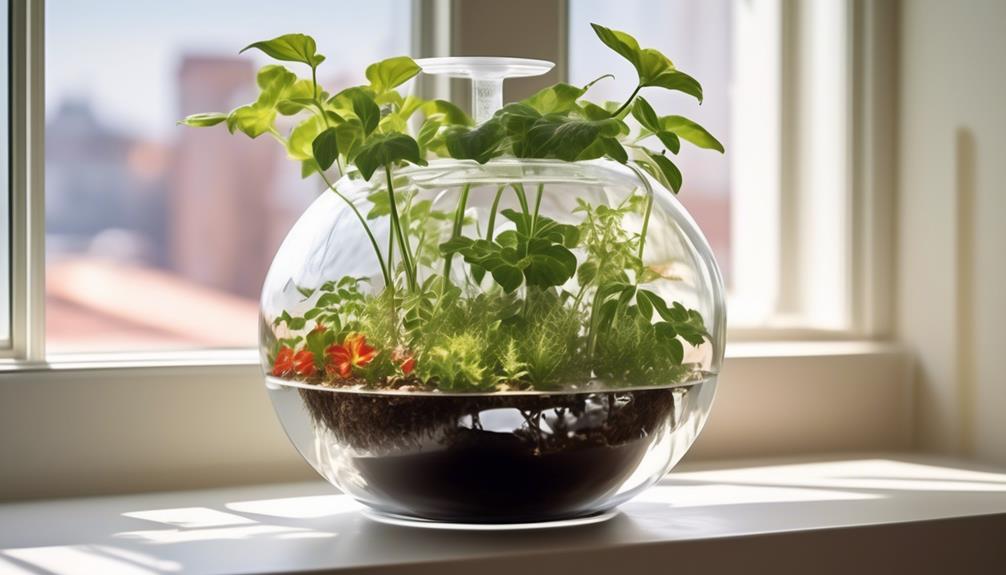
Placing self watering pots in well-lit areas can enhance plant growth and ensure optimal moisture regulation. When deciding on the ideal placement for self watering pots, it is crucial to consider proper sunlight exposure and room temperature. For most indoor plants, the ideal placement would be near a window that receives bright, indirect sunlight for a significant part of the day. It's important to avoid direct sunlight as it can lead to overheating and drying out the soil. Additionally, maintaining room temperature is essential for the overall health of the plants.
| Sunlight Exposure | Room Temperature |
|---|---|
| Bright, indirect sunlight for a significant part of the day | 65-75°F (18-24°C) |
Placing self watering pots near windows with proper sunlight exposure and maintaining the recommended room temperature will contribute to the overall well-being of the plants, ensuring that they thrive and flourish. By adhering to these placement guidelines, the self watering pots can effectively support the growth and health of the plants.
Tips for Successful Plant Growth
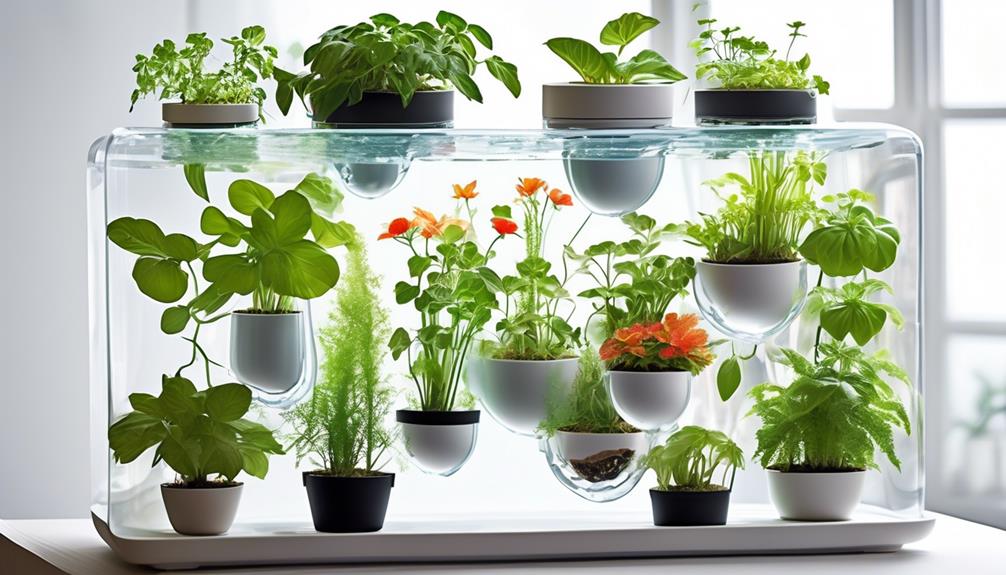
We have found that maintaining consistent moisture levels in the soil is crucial for successful plant growth in self watering pots.
Here are some tips for achieving optimal plant growth in self watering pots:
- Monitor Soil Moisture: Regularly check the moisture level of the soil using a moisture meter or by simply inserting your finger into the soil. Adjust the watering frequency based on the plant's specific needs to prevent overwatering or underwatering.
- Ensure Proper Sunlight Exposure: Place the self watering pot in an area that receives adequate sunlight based on the plant's requirements. Different plants have varying light needs, so it's important to understand the sunlight requirements of the specific plant you're growing.
- Use High-Quality Soil: Choose a well-draining potting mix that's specifically formulated for the types of plants you're growing. The right soil composition is essential for maintaining proper moisture levels and providing essential nutrients to the plants.
- Regular Maintenance: Periodically check the pot's reservoir to ensure it's clean and free from any blockages. Clear away any debris that may impede water flow, as this can affect the plant's access to water and nutrients.
Cleaning and Caring for Your Transparent Pot

When caring for our transparent self-watering pot, there are a few important considerations:
- Addressing mineral deposits that can accumulate on the inside of the pot.
- Taking steps to prevent algae growth, which can obstruct the transparent view of the pot and potentially harm the plant.
- Handling the delicate materials of the pot carefully to avoid any damage during the cleaning process.
Removing Mineral Deposits
To effectively remove mineral deposits from your transparent self-watering pot, start by mixing a solution of equal parts white vinegar and water. Follow these steps for best results:
- Soaking: Disassemble the pot and soak the affected parts in the vinegar and water solution for at least 30 minutes to loosen the mineral deposits.
- Scrubbing: Use a soft-bristled brush or a sponge to gently scrub the deposits away. For stubborn spots, a paste of baking soda and water can be used as a gentle abrasive.
- Rinsing: Thoroughly rinse the pot with clean water to remove any remaining vinegar or baking soda residue.
- Drying: Allow the pot to air dry completely before reassembling and refilling it with water and soil.
Following these steps will ensure your transparent self-watering pot remains free from unsightly mineral deposits.
Preventing Algae Growth
To prevent algae growth and maintain the cleanliness of your transparent self-watering pot, regularly wiping the interior with a diluted solution of mild soap and water is recommended.
Algae thrives in moist environments, and the self-watering feature of the pot provides an ideal breeding ground.
In addition to regular cleaning, consider placing the pot in a location with indirect sunlight to discourage algae growth.
Furthermore, using distilled water instead of tap water can help prevent the buildup of algae and mineral deposits.
When refilling the water reservoir, ensure that no spills occur, as any water residue on the exterior of the pot can also contribute to algae growth.
Handling Delicate Materials
Regularly cleaning and caring for your transparent pot is essential to maintain its delicate materials and ensure the overall health of your plants. When handling delicate materials, it's crucial to follow specific cleaning and maintenance procedures to avoid damage. Here are some tips for cleaning and caring for your transparent self-watering pot:
- Use a soft, non-abrasive cloth or sponge to gently wipe the pot's surface to avoid scratching.
- Clean the pot with mild soap and water to remove dirt and residue without causing harm to the fragile materials.
- Ensure thorough drying to prevent moisture-related damage to the pot's delicate components.
- Regularly check the moisture control system to guarantee proper plant nurturing without compromising the pot's delicate structure.
Troubleshooting Common Self Watering Pot Issues
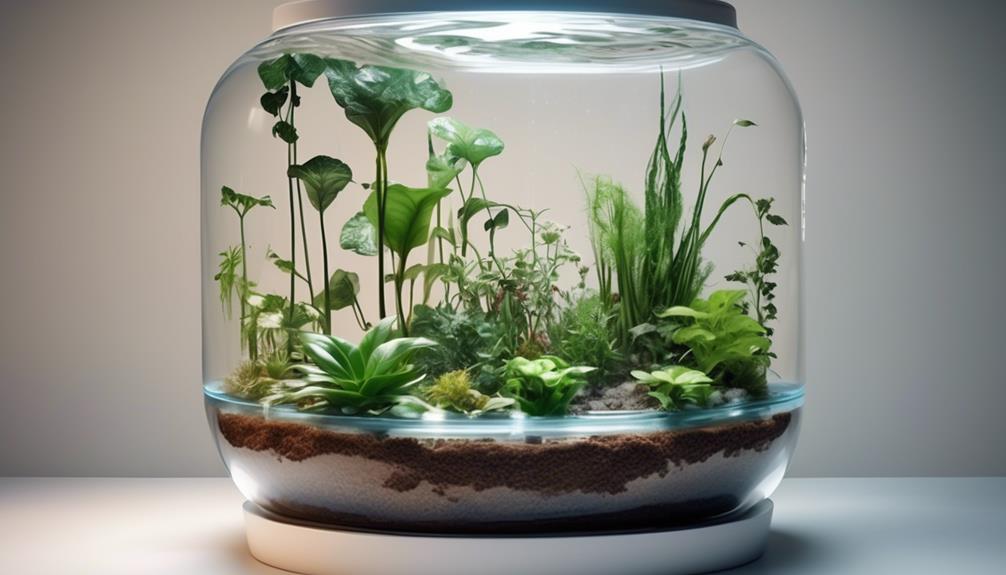
When troubleshooting common self watering pot issues, it's important to first ensure that the watering system is functioning properly before exploring other potential problems.
One common issue is the soil drying out too quickly, which can be resolved by adding more water to the reservoir or using a moisture-retaining soil mix.
If the soil is consistently waterlogged, it may indicate a malfunction in the wicking system, and adjusting the wick or replacing it with a more efficient one can rectify this problem.
Another frequent problem is mold growth, often caused by excessive moisture and poor air circulation. This can be addressed by reducing watering frequency, increasing ventilation, or adding a layer of gravel to the bottom of the pot to improve drainage.
Additionally, mineral deposits can clog the watering system over time, leading to uneven water distribution. Regular cleaning and flushing of the reservoir and watering mechanisms with a vinegar solution can help prevent this issue.
Enhancing Plant Care With Additional Accessories

As plant care enthusiasts, we understand the importance of addressing common self-watering pot issues, and now we'll explore how to enhance plant care with additional accessories.
Enhancing plant care with additional accessories can significantly improve plant hydration and overall growth. Here are four essential indoor gardening accessories to consider:
- Humidity Trays: These trays are designed to hold water and create a humid environment around plants. They help in maintaining optimal moisture levels, especially for plants that require higher humidity.
- Adjustable Plant Stands: These stands provide flexibility in adjusting the height of plants, ensuring they receive adequate light and air circulation. Proper positioning can greatly impact a plant's health and growth.
- Watering Globes: These are useful for supplementing the self-watering feature of pots, ensuring a continuous water supply to the plants, especially during periods of low humidity or when you're away from home.
- Moisture Meters: These devices help in accurately measuring the moisture content in the soil, allowing you to water your plants precisely when needed, preventing both overwatering and underwatering.
Sustainable and Eco-Friendly Features
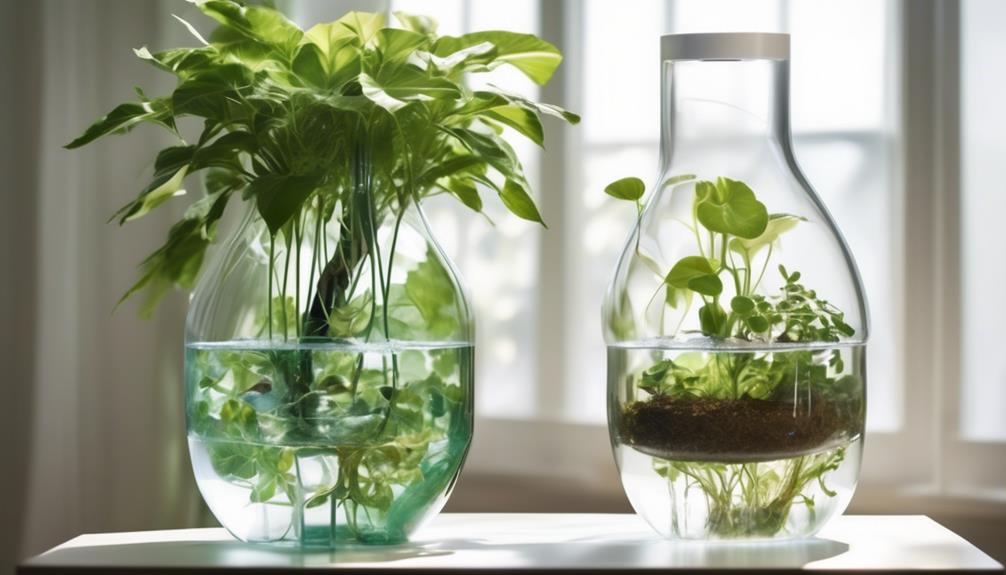
Exploring sustainable and eco-friendly features in plant care involves integrating innovative technologies and materials to minimize environmental impact while optimizing plant health and growth.
Sustainable design is a key aspect of the transparent self-watering pot. The pot is made from recycled and recyclable materials, reducing the overall carbon footprint. It also incorporates water conservation techniques, such as a built-in reservoir that collects and reuses excess water, minimizing water wastage.
This feature not only promotes sustainable water usage but also ensures that plants receive consistent moisture, supporting their overall health and vitality.
In addition, the self-watering pot utilizes natural processes, such as capillary action, to deliver water to the plant's roots as needed, reducing the reliance on traditional irrigation methods. By harnessing these natural mechanisms, the pot conserves water while promoting efficient plant hydration.
Furthermore, the transparent design allows for easy monitoring of water levels, enabling users to gauge precisely when refills are necessary, thus preventing overwatering or underwatering.
Frequently Asked Questions
Can the Transparent Self Watering Pot Be Used Outdoors?
Yes, the transparent self watering pot can be used outdoors.
When using the pot outdoors, it's important to consider factors such as sunlight exposure, temperature variations, and potential environmental damage.
To ensure successful outdoor use, we recommend placing the pot in a location with adequate sunlight, monitoring the water level regularly, and providing proper drainage to avoid waterlogging.
Following these maintenance tips will help optimize the pot's performance in an outdoor setting.
Are There Any Specific Types of Soil That Work Best With Self Watering Pots?
When it comes to self watering pots, the best soil is one that has good water retention and drainage capabilities to support the watering system.
Some plant types may require specific soil compositions, but generally, a well-balanced mix with organic matter and perlite works well.
Adding a layer of gravel or sand at the bottom can enhance drainage.
Regularly topping up the water reservoir and adding a diluted fertilizer solution will help maintain healthy plant growth.
Can the Self Watering System Be Adjusted for Different Plant Types?
Yes, the self watering system can be adjusted for different plant types.
The adjustable settings allow for plant specific adjustments, such as varying the amount of water delivered to different types of plants.
This level of customization ensures that each plant receives the appropriate amount of water, promoting optimal growth and health.
It's a practical feature for those looking to maintain a variety of plants with different watering needs.
How Often Should the Water Reservoir Be Refilled in the Self Watering Pot?
We should regularly check and refill the water reservoir in the self-watering pot to maintain optimal plant health. The refilling frequency depends on factors such as plant type, size, and environmental conditions.
A general maintenance schedule involves checking the water level weekly and refilling as needed. This ensures that the plants receive a consistent water supply, promoting healthy growth.
Proper maintenance of the water reservoir is crucial for the overall well-being of the plants.
Can Fertilizer Be Added to the Water Reservoir in the Self Watering Pot?
Yes, fertilizer can be added to the water reservoir in the self watering pot. However, it's important to use a diluted solution to prevent root burn and carefully monitor the plant's response.
Additionally, adjust the watering frequency to account for the added nutrients, as the plant may require less frequent watering. This practice ensures the plant receives a balanced supply of water and nutrients, promoting healthy growth.
Will Using a Transparent Self-Watering Pot Help Prevent Root Rot?
Using self watering pots can indeed help prevent root rot in plants. The transparent design allows for easy monitoring of water levels, ensuring that the plants receive the right amount of moisture. This can prevent overwatering, one of the main causes of root rot.
Conclusion
In conclusion, the transparent self watering pot offers a practical and eco-friendly solution for plant care.
By utilizing the self watering system, choosing the right plants, and monitoring water levels, you can enhance the health and longevity of your plants.
With the added benefit of sustainability and transparency, this pot provides a clear view of the water levels and promotes a greener approach to plant care.
Self Watering Plant Pots
Self Watering Outdoor Pots: Do They Work?
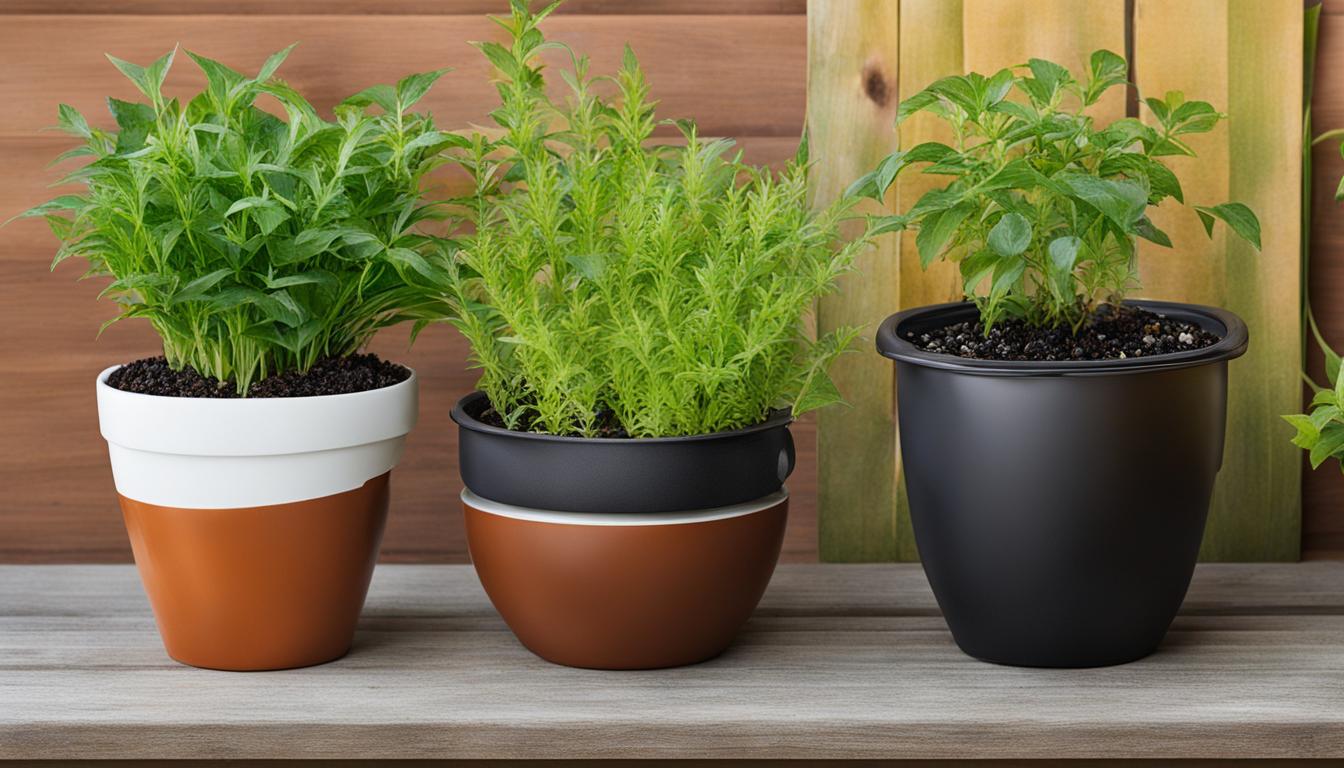
Transforming your garden into a flourishing paradise should feel as easy as a leisurely walk in the park. The key to nurturing healthy, lively plants is quite simple: make sure they’re consistently nourished and content! Introducing **self-watering outdoor pots**. These clever pots are creating a stir among garden enthusiasts for their capacity to maintain optimal hydration for your plant companions, allowing them to thrive while you take it easy. Yet, do they really stand up to their reputation? Let’s delve deeper to uncover the reality.
Self-watering pots are designed with a built-in water reservoir, which eliminates the need for daily watering. The potting soil acts as a wick, drawing water from the reservoir to the plant’s roots through capillary action. This ensures a steady and consistent water supply, preventing both under and overwatering.
These pots are suitable for a variety of plant types, offering convenience for gardeners with busy schedules. However, plants that prefer drier conditions may not do well in self-watering pots, as the moisture levels are consistently higher. It’s important to consider the specific needs of your plants before choosing this watering solution.
Self-watering pots are not only convenient but also environmentally friendly. They conserve water by delivering it directly to the roots, minimizing wastage. Additionally, they prevent excess water from pooling and causing root rot, promoting healthier plant growth.
While self-watering pots are a great solution for regular watering needs, they do have their limitations. These pots do not detect weather conditions, so they may require additional monitoring during humid or rainy periods. It’s also essential to maintain proper drainage and avoid mosquito breeding by regularly cleaning and maintaining the pots.
Key Takeaways:
- Self-watering outdoor pots provide a convenient solution for busy gardeners.
- They save time and conserve water by delivering moisture directly to the plant’s roots.
- Not all plants thrive in self-watering pots, especially those that prefer drier conditions.
- Monitoring is necessary during humid or rainy periods.
- Regular maintenance is important to ensure proper drainage and prevent mosquito breeding.
How Do Self-Watering Pots Work?
Self-watering pots are designed to provide a continuous water supply to plants, ensuring they stay healthy and hydrated. The ingenious mechanism behind these pots involves a simple yet effective process.
The self-watering pot consists of a built-in reservoir at the bottom, which serves as a water storage unit. This reservoir holds water, providing a reservoir for the plants to draw from. The soil in the pot acts as a wick, naturally pulling water from the reservoir up to the plant’s roots through capillary action.
This bottom-up watering system is crucial in maintaining a consistent supply of water to the plants. Through the process of capillary action, the porous soil gradually absorbs the water from the reservoir, creating a moisture gradient that allows the roots to draw in water as needed.
The capillary action ensures that excess water is prevented from accumulating in the pot, as any surplus water will drain back into the reservoir. This helps to prevent overwatering and root rot, allowing the plants to thrive in a well-maintained and balanced moisture environment.
To ensure the self-watering pot functions optimally, the reservoir needs to be periodically filled with water. The frequency of refilling depends on the specific water requirements of the plant and the size of the pot’s reservoir. Typically, it is recommended to refill the reservoir every one to two weeks, but closely monitoring the moisture level and the plant’s needs is key to maintaining its health.
Self-watering pots offer an efficient and convenient solution for gardeners, ensuring plants receive a consistent water supply without the need for frequent manual watering. This makes them an excellent choice for busy individuals or those who may have difficulty keeping up with regular watering schedules.
Benefits of Self-Watering Pots:
- Convenient watering solution for busy gardeners
- Conserves water and prevents overwatering
- Promotes healthy root growth
- Suitable for a wide range of plant varieties
With their innovative design and practical functionality, self-watering pots have revolutionized the way we care for our plants. Their ability to provide a reliable and consistent water supply contributes to healthier, more thriving plants.
Benefits of Self-Watering Pots
Self-watering pots provide numerous benefits for gardeners, making them a popular choice for plant enthusiasts. Let us explore the advantages of using self-watering pots:
- Convenience: Busy gardeners who may not have the time to water their plants regularly can benefit greatly from self-watering pots. These innovative pots automate the watering process, ensuring that your plants receive the necessary moisture consistently.
- Water Conservation: With self-watering pots, you can say goodbye to wasted water. These pots deliver water directly to the plant’s roots, preventing excessive watering and reducing water waste. The reservoir design allows for controlled water distribution, providing plants with just the right amount of moisture.
- Healthy Root Growth: The self-watering system promotes healthy root development by supplying water from the bottom of the pot. This encourages plants to develop robust root systems, making them more resilient and better able to absorb nutrients from the soil.
- Versatility: Self-watering pots are suitable for a wide range of plant varieties, including vegetables, herbs, and annuals. Whether you’re growing tomatoes, basil, or vibrant flowers, self-watering pots can provide the ideal environment for your plants to thrive.
- Vacation Care: Going on vacation? Self-watering pots can be an excellent solution for keeping your plants hydrated and healthy in your absence. By filling the reservoir before leaving, you can rest assured that your plants will receive adequate water throughout your time away.
Overall, self-watering pots offer convenience, water conservation, promote healthy root growth, and accommodate various plant types. They are particularly beneficial for individuals with busy schedules or those who enjoy weekend getaways.
Now, let’s take a closer look at how self-watering pots work in section 4.
The benefits of self-watering pots:
| Benefits | Description |
|---|---|
| Convenience | Automates watering process, ideal for busy gardeners. |
| Water Conservation | Reduces water waste and provides controlled water distribution. |
| Healthy Root Growth | Encourages robust root systems and nutrient absorption. |
| Versatility | Suitable for various plant types, including vegetables and herbs. |
| Vacation Care | Keeps plants hydrated during extended periods of absence. |
Advantages of Self-Watering Pots
Self-watering pots offer numerous advantages that make them a popular choice among gardeners. These pots provide a range of benefits, including:
- Nutrient Retention: Self-watering pots help to retain nutrients in the soil, promoting healthy plant growth and development.
- Water Conservation: By slowly releasing water into the soil, self-watering pots minimize water loss through evaporation, making them a water-efficient option.
- Root Growth Stimulation: The deep watering provided by self-watering pots stimulates root growth, resulting in stronger and healthier plants.
- Ability to Grow Exotic Plant Species: Self-watering pots allow the growth of exotic plants that may require regular and adequate watering, expanding the range of plants that can be cultivated.
Overall, self-watering pots provide an effective and convenient solution for maintaining plants’ watering needs while offering additional benefits that contribute to the overall health and growth of the plants.
Advantages of Self-Watering Pots
| Advantages | Description |
|---|---|
| Nutrient Retention | Helps to retain nutrients in the soil, promoting healthy plant growth. |
| Water Conservation | Reduces water loss through evaporation, making it a water-efficient option. |
| Root Growth Stimulation | Stimulates root growth, resulting in stronger and healthier plants. |
| Ability to Grow Exotic Plant Species | Allows the growth of exotic plants that require regular watering. |
Table 4: Advantages of Self-Watering Pots
These advantages make self-watering pots a valuable tool for gardeners who want to ensure optimal plant health and growth while minimizing water usage.
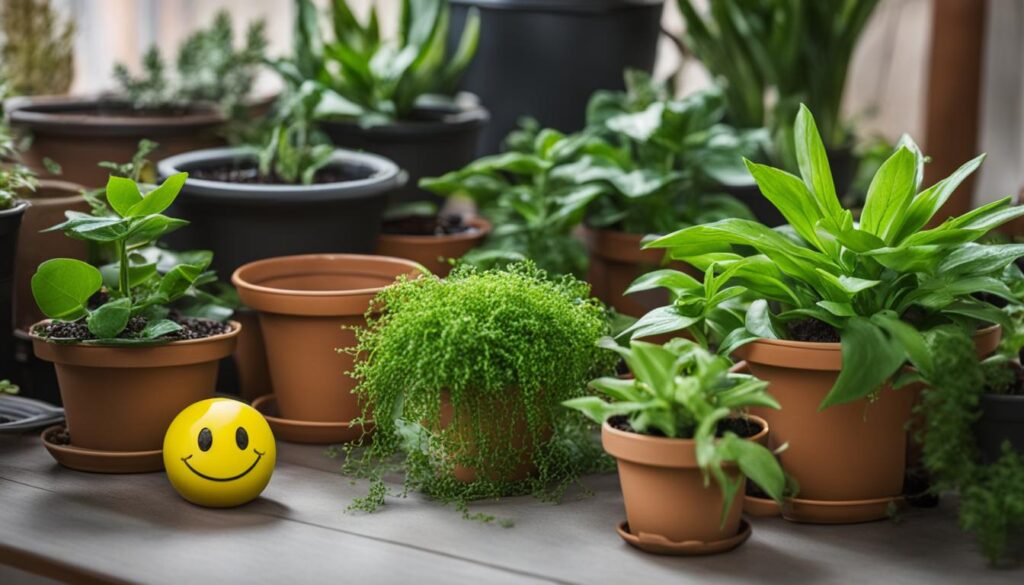
Considerations for Self-Watering Pots
While self-watering pots have many benefits, there are some important factors to consider when using them. Not all plants are suitable for self-watering pots, as some prefer drier conditions and well-drained soil. Plants like succulents and cacti, which thrive in arid environments, may not fare well in self-watering pots due to the consistent moisture they provide.
One consideration to keep in mind is water conservation. While self-watering pots are designed to be efficient, they may not always detect environmental factors like rain or humidity. This can result in the continuous release of water, leading to potential water waste. It’s important to be mindful of the water levels in the reservoir and adjust accordingly to avoid overwatering.
Another factor to consider is regular maintenance. Self-watering pots need proper drainage to prevent waterlogging and mosquito breeding. Checking the drainage system and cleaning the pot periodically is essential to ensure the longevity of the plants and the pot’s functionality.
“Not all plants are suitable for self-watering pots.”
Overall, while self-watering pots can be a convenient and effective solution for plant care, it’s essential to choose the right plants and be mindful of water conservation and maintenance to ensure optimal results.
Style and Cost of Self-Watering Pots
When it comes to self-watering pots, there is no shortage of options to suit your style and budget. These innovative pots come in various styles, sizes, and materials, allowing you to find the perfect fit for your outdoor plants. Whether you prefer sleek black pots, minimalist white designs, or the timeless charm of concrete, there is a self-watering pot to match your aesthetic preferences.
For those looking to make a statement, larger planter styles and wall features are available, adding a touch of elegance and versatility to your garden. Window boxes are another popular choice, combining functionality with an attractive display of cascading flowers or herbs.
When it comes to cost, self-watering pots may have a higher price tag compared to standard pots initially. However, they can be a wise investment in the long run. By reducing water bills and preventing plant loss, these pots can save you money over time. The cost of self-watering pots varies depending on the size and style you choose, ensuring there is a suitable option for every budget.
Comparison Table: Self-Watering Pot Styles and Prices
| Style | Description | Price Range |
|---|---|---|
| Simple Pots | Classic designs in black, white, or concrete | $10 – $30 |
| Planter Styles | Larger pots with elevated designs | $30 – $100 |
| Wall Features | Pots designed for vertical gardens | $50 – $150 |
| Window Boxes | Pots specifically designed for windowsills | $20 – $50 |
As seen in the table above, self-watering pots offer a range of styles and price points, making it possible to find the perfect fit for your outdoor space. Consider your plant type, space availability, and personal taste to choose the self-watering pots that will enhance the beauty of your garden while providing the convenience of automated watering.
DIY Self-Watering Systems
If you enjoy DIY projects and want to save some money, creating your own self-watering system is a great option. There are numerous online tutorials available that provide step-by-step instructions to help you build a DIY self-watering system using easily accessible materials. By crafting your own self-watering system, you can personalize it to suit your garden’s specific needs while also being more economical. However, it is crucial to ensure proper construction and functionality to avoid any water leakage or other potential issues.
Advantages of DIY Self-Watering Systems
Building your own self-watering system offers several advantages:
- Cost-Effectiveness: DIY self-watering systems can be more affordable compared to purchasing pre-made self-watering pots or systems.
- Customization: You can design and customize the self-watering system to fit the size and style of your plants or garden.
- Control: With a DIY system, you have direct control over the construction and can ensure its efficacy and longevity.
- Flexibility: As your garden expands or changes, you can easily modify or expand your DIY self-watering system accordingly.
Creating a DIY self-watering system allows you to exercise your creativity while also being environmentally conscious. By repurposing common household items or utilizing inexpensive materials, you can achieve the same benefits as store-bought solutions. Just make sure to follow reliable tutorials and consider the specific needs of your plants.
“Building your own self-watering system can be a fun and rewarding DIY project. By utilizing easily available materials and following step-by-step instructions, you can create a personalized and cost-effective solution for your garden.” – Expert Gardener
Step-by-Step Guide: Building a DIY Self-Watering System
- Gather the necessary materials: A reservoir container, a growing container (pot or planter), a wicking material (such as a cotton rope or capillary mat), potting soil, and plants.
- Prepare the reservoir container: Drill a small hole near the bottom of the container for water drainage. This hole will prevent overwatering and waterlogging.
- Assemble the wicking system: Place the wicking material in the reservoir container, ensuring it extends from the bottom of the container and sticks out slightly above the container’s rim.
- Add potting soil: Fill the growing container with potting soil, leaving enough space at the top for planting your desired plants.
- Plant your plants: Make small holes in the soil and gently place your plants, ensuring they are well-anchored and surrounded by soil.
- Connect the reservoir container: Position the reservoir container next to or underneath the growing container, making sure the wicking material extends into the soil. The reservoir container will supply water to the plants through the wicking material.
- Test and adjust: Pour water into the reservoir and observe how the wicking system distributes the water to the plants. Adjust the wicking material and the amount of water as necessary to achieve the desired watering effect.
Remember to monitor your DIY self-watering system regularly, ensuring that the reservoir is refilled when necessary and the plants are healthy. With a properly constructed DIY self-watering system, you can enjoy a thriving garden with less effort and water wastage.
| Advantages of DIY Self-Watering Systems | Step-by-Step Guide |
|---|---|
|
|
By following a step-by-step guide and utilizing readily available materials, you can create a functional and efficient DIY self-watering system for your garden. Enjoy the satisfaction of creating a personalized solution while keeping your plants hydrated and healthy.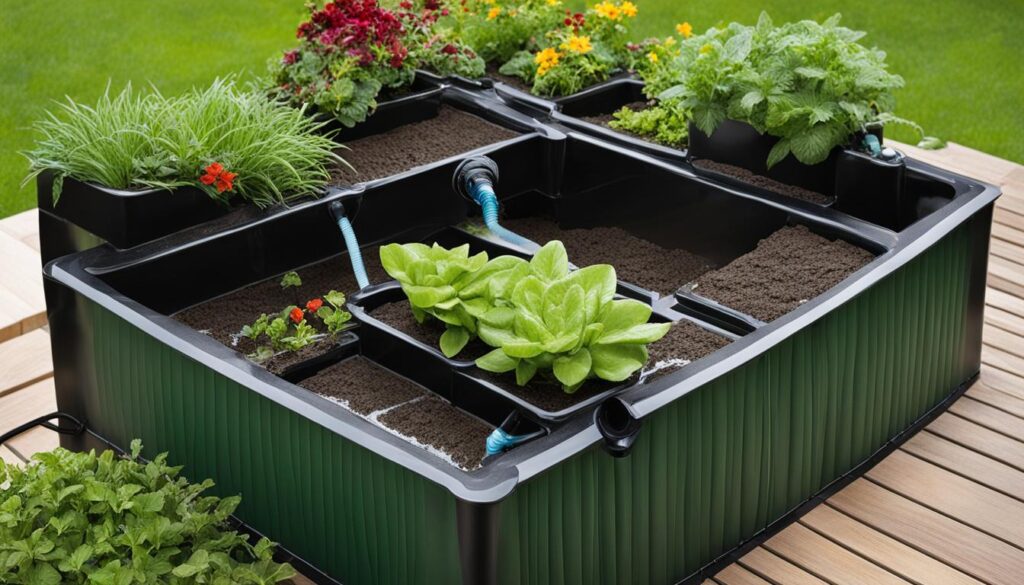
Self-Watering Pots for Vacation Care
When you’re planning a vacation, taking care of your plants can be a concern. With self-watering pots, you can enjoy your time away without worrying about your plants getting thirsty. These innovative pots provide a reliable watering system that keeps your plants hydrated even when you’re not around.
Before you leave, make sure to fill the reservoir of your self-watering pot with water. This reservoir acts as a water source for your plants, supplying them with the moisture they need to thrive. Depending on the size of the reservoir and the water requirements of your plants, you may only need to fill it once or twice throughout your vacation.
If you have a trusted friend, neighbor, or family member nearby, you can ask them to check on your self-watering pot periodically. They can ensure that the reservoir is still filled with water and that everything is functioning properly. This extra set of eyes can provide peace of mind and ensure that your plants continue to receive the care they need.
“I’ve used self-watering pots for vacation care multiple times, and I’ve always come back to healthy, happy plants,” says Rebecca, a frequent vacationer and plant enthusiast. “It’s such a relief to know that my plants are being taken care of while I’m away. I highly recommend self-watering pots for anyone who loves to travel.”
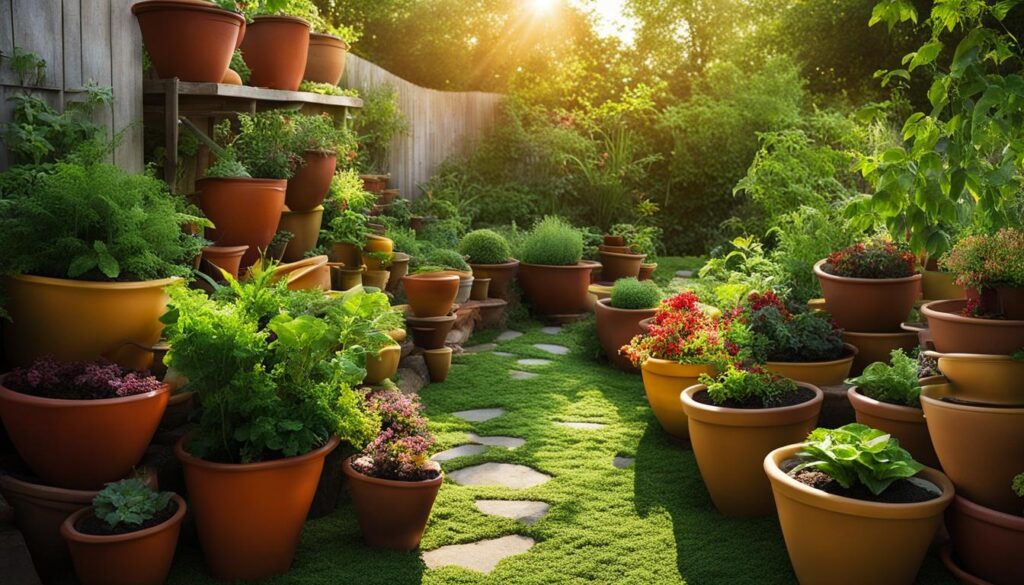
Benefits of Self-Watering Pots for Vacation Care
- Reliable watering system: Self-watering pots ensure that your plants receive a consistent supply of water, even in your absence.
- Peace of mind: You can enjoy your vacation knowing that your plants are being taken care of.
- Plant health and vitality: Self-watering pots provide the right amount of moisture to keep your plants healthy and thriving.
- Convenience: No need to rely on others to water your plants or worry about overwatering.
- Water conservation: Self-watering pots are designed to prevent water waste, making them an eco-friendly option.
With self-watering pots, you can have beautiful, thriving plants waiting for you when you return from your vacation. So go ahead, plan that well-deserved getaway, and let your self-watering pots take care of your plants in the meantime.
Are Self-Watering Pots Suitable for All Plants?
While self-watering pots offer numerous advantages, it is important to note that not all plants thrive in these systems. Certain plant species, such as succulents, cacti, and Mediterranean herbs, prefer drier conditions and well-drained soil. The consistent moisture provided by self-watering pots may not align with their specific watering needs, potentially leading to root rot and other issues.
Before deciding to use a self-watering pot, it is crucial to consider the water requirements and preferences of each plant. Some plants may benefit from the convenience and efficiency of a self-watering system, while others may require manual watering or alternative methods.
“Not all plants are suitable for self-watering pots.”
Plants Suitable for Self-Watering Pots
There is a wide range of plant varieties that can thrive in self-watering pots. These include:
- Leafy greens, such as lettuce and spinach
- Herbs, like basil, parsley, and mint
- Small to medium-sized vegetables, including tomatoes, peppers, and cucumbers
- Flowering plants, such as marigolds, petunias, and geraniums
These plants typically benefit from consistent moisture and can adapt well to the self-watering system. However, it is essential to monitor their water intake and adjust the watering frequency accordingly.
| Plant Name | Watering Needs | Suitability for Self-Watering Pots |
|---|---|---|
| Lettuce | Regular, consistent moisture | High suitability |
| Basil | Regular watering, but avoid over-saturation | High suitability |
| Tomatoes | Moderate watering, with more during fruiting | Medium suitability |
| Marigolds | Regular watering, but avoid excessive moisture | High suitability |
As illustrated in the table above, certain plants are better suited for self-watering pots than others. It is important to consider the specific watering needs and moisture requirements of each plant to ensure their successful growth in a self-watering system.
By selecting plants that are compatible with self-watering pots, gardeners can enjoy the convenience and efficiency of these systems while promoting healthy plant growth. Remember to provide appropriate plant care, monitor water levels, and adjust watering schedules as needed to optimize the benefits of self-watering pots.
Conclusion
Self-watering outdoor pots are an excellent choice for gardeners looking for a convenient and efficient way to maintain healthy plants. With their ability to provide a consistent water supply directly to the roots, these pots save time and reduce water waste. However, it’s crucial to carefully select the right plants for self-watering pots and consider environmental conditions and maintenance requirements.
When it comes to self-watering pots, there is a wide range of styles and price ranges available, ensuring that every gardener can find the perfect fit for their needs. Whether you opt for pre-made self-watering pots or decide to embark on a DIY project, the benefits are undeniable. These pots can be a valuable tool in keeping your outdoor plants thriving throughout the year.
When choosing the best self-watering pots, consider the size and style that suit your garden aesthetic and the specific requirements of your plants. Look for pots made from durable materials that will withstand the outdoor elements and ensure long-lasting use. By investing in high-quality self-watering pots, you can enjoy the convenience and efficiency they offer for years to come.
FAQ
Do self-watering outdoor pots work?
Yes, self-watering outdoor pots work by using a reservoir at the bottom to hold water. The soil in the pot acts as a wick, pulling water from the reservoir up to the plant’s roots through capillary action.
How do self-watering pots work?
Self-watering pots work by utilizing a bottom-up watering system. The reservoir at the bottom holds water, and the soil in the pot acts as a wick, pulling water up to the plant’s roots. This ensures a consistent supply of water and prevents excess water accumulation.
What are the benefits of self-watering pots?
Self-watering pots offer several benefits, including convenience for busy gardeners, water conservation, healthy root growth, and the ability to support various plant varieties. They provide a convenient watering solution, conserve water by delivering the right amount of moisture directly to the roots, and promote healthy plant growth.
What are the advantages of self-watering pots?
There are several advantages to using self-watering pots. They help retain nutrients in the soil, conserve water by minimizing evaporation, stimulate root growth for stronger plants, and enable the growth of plants with specific watering needs, such as exotic plant species.
What should I consider when using self-watering pots?
When using self-watering pots, it is important to consider the water requirements and preferences of the plants. Not all plants are suitable for self-watering pots, as some prefer drier conditions and well-drained soil. Additionally, self-watering pots may not detect external factors like rain or humidity, so monitoring and maintenance are necessary.
What is the style and cost range of self-watering pots?
Self-watering pots come in various styles, sizes, and materials. They range from simple pots in black, white, or concrete to larger planter styles and even wall features or window boxes. The cost of self-watering pots varies depending on the size and style chosen.
How can I create my own self-watering system?
If you enjoy DIY projects, you can create your own self-watering system using readily available materials. There are many tutorials available online that provide step-by-step instructions on building a self-watering system. DIY self-watering systems can be a more economical and personalized option for enhancing your garden.
Are self-watering pots suitable for vacation care?
Yes, self-watering pots are a popular choice for vacation care. They provide a reliable watering system that can keep plants hydrated while you are away. Before leaving, the reservoir should be filled with water, and if needed, a friend or neighbor can check on the self-watering pot periodically.
Are self-watering pots suitable for all plants?
Not all plants are suitable for self-watering pots. Plants that prefer drier conditions, such as succulents, cacti, and Mediterranean herbs, may not thrive in self-watering systems. It is important to consider the water requirements and preferences of each plant before deciding to use a self-watering pot.
What are the best self-watering pots?
The best self-watering pots may vary depending on individual needs and preferences. It is recommended to choose self-watering pots that meet the specific requirements of the plants being grown and fit the desired aesthetic. Various reputable brands offer high-quality self-watering pots, so researching and reading reviews can help in making the best choice.
With a green thumb and a keen eye for detail, Kayla leads our content with expertise and enthusiasm. Her dedication to spreading the joy of home gardening is reflected in every piece of advice and tip shared. She ensures that our community receives the most reliable and practical gardening insights.
-
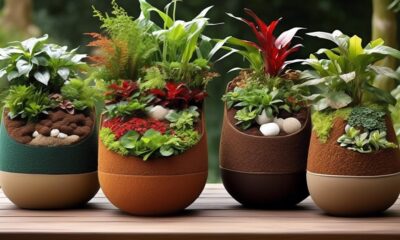
 Vetted5 days ago
Vetted5 days ago15 Best Wicking Materials for Self-Watering Planters, Tried and Tested
-
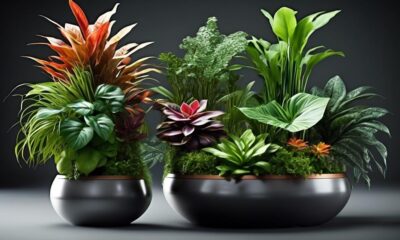
 Vetted3 weeks ago
Vetted3 weeks ago15 Best Self-Watering Pots to Keep Your Plants Thriving
-

 Vetted3 weeks ago
Vetted3 weeks ago15 Best Terrace Planters to Elevate Your Outdoor Space
-
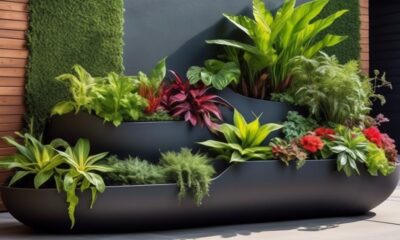
 Vetted3 weeks ago
Vetted3 weeks ago15 Best Wicking Planters to Keep Your Plants Thriving and Healthy
-
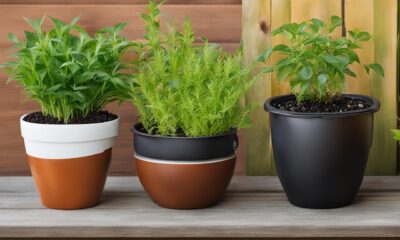
 Self Watering Plant Pots1 week ago
Self Watering Plant Pots1 week agoSelf Watering Outdoor Pots: Do They Work?
-

 Vetted3 weeks ago
Vetted3 weeks ago15 Best Waterwick Pots to Keep Your Plants Thriving and Healthy
-
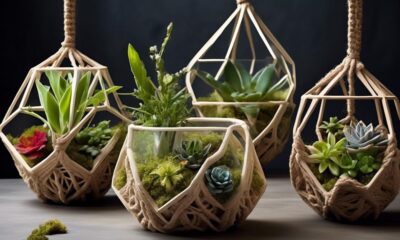
 Vetted3 weeks ago
Vetted3 weeks ago15 Unique and Wicked Planters to Elevate Your Indoor Garden
-

 Vetted3 weeks ago
Vetted3 weeks ago15 Best Self-Watering Plants for Busy Plant Lovers – Never Worry About Overwatering Again















